The Destroyer
The Destroyer"If the soldiers are strong and the officers are weak there will be insubordination."
~ Sun Tzu, Art of War
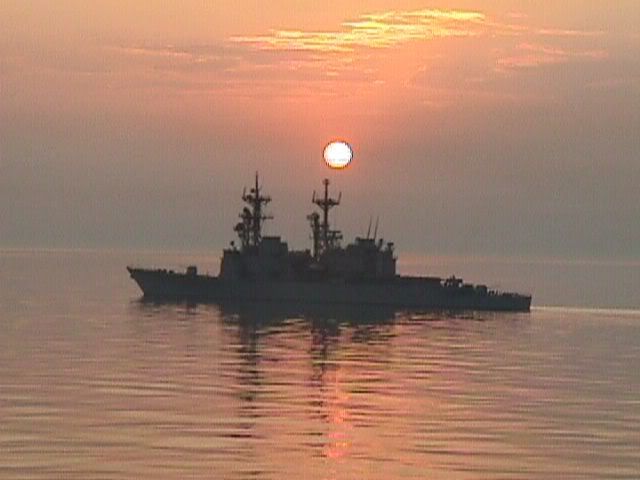
USS Elliot DD-967, North Arabian Gulf, 1998.
USS Elliot DD-967, North Arabian Gulf, 11 August 1998: A shipmate awoke me near midnight from the tiny rack where I slept. The ship’s Executive Officer (XO) had called our berthing telephone, despite standing orders for silence about the decks between 2200L and 0600L. Each night at sea, at 2200L, the Boatswain Mate of the Watch (BMOW), at the direction of the Officer Of the Deck (OOD), would announce via the 1MC (ship's intercom system) from the bridge "Taps, taps, lights out, maintain silence about the decks, now taps." At 0600L the wake-up would be passed as "Revelry, revelry, revelry, all hands heave out and trice up." Ringing a telephone in our berthing space between these times did not qualify as "silence about the decks." I thought this unusual call must be important.
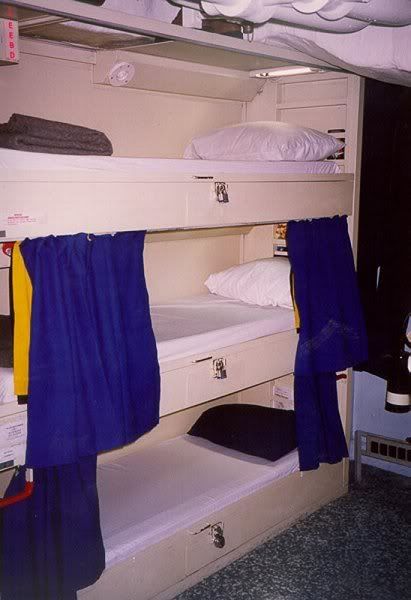
A typical berthing space.
I was the sole Intelligence Specialist on board (IS1-3905). Everyone knew me as "IS1." Only a very few of the crew knew my given name. As I awoke in our darkened berthing space, I heard the deep urgent thrum of the engines and felt the vibration of the deck as our ship drove urgently through the water. We were speeding somewhere new as I collected the telephone from a curious shipmate, and answered, "IS1, speaking."
"XO here. We have orders to transit the Strait tonight. Anything out there?" That meant we were detaching from the Abraham Lincoln Carrier Battle Group (CVBG).
I had been keeping my eye on the Strait of Hormuz even before Osama bin Ladin’s al Qaeda had bombed our embassies in Kenya and Tanzania on 07 August 1998. The Strait, controlled by the Iranians, was our only way in and out of the Arabian Gulf: our backdoor, so to speak. Any competent Intelligence Specialist would have done the same. I answered "An Iranian Navy Delvar AWT (Auxiliary Water Tanker) on picket duty (Strait of Hormuz Security Patrol)." A Water Tanker is similar to an Oil Tanker but carries the Middle East’s most precious natural resource from the local perspective. That this vessel was Iranian Navy and not Iranian Revolutionary Guard, was also significant: the former were typically highly professional, the latter, well, not so much.
"What’s it armed with?"
"12.7mm machine guns." I added "They’ll contact us as soon as they detect us. We can expect professional comms (communications) - no hostilities." Those machine guns did not represent much of a threat except at close quarters. Every US Navy surface combatant - with the exception of the Arleigh Burke class destroyers - has an aluminum superstructure. Our ship was no exception. Everything from 7.62mm and up will do a through-and-through on aluminum: in one side and out the other. Ideologies aside, untold trillions of taxpayer dollars spent on "defense" over the past too many decades have never reached the field or the fleet.
"Where are the Kilo’s?" the XO asked, referring to Iran’s three Kilo SS submarines.
"All three are in port" was my response. I'd had kept my eye out for them too.
"Thanks, IS1. I’ll pass that to the CO." He was referring to our Commanding Officer (CO).
I was confident enough of my assessment that I went back to sleep. I suspected rack-time would be a commodity in the days to come, though I could only guess at the details. At just past 0300L, the Iranian OOD on board the Delvar AWT radioed our OOD and asked in crisp, polite English for us to identify ourselves. This was their right, as the Strait of Hormuz is within Iranian territorial waters. We identified ourselves, and passed without incident.
I had established a solid reputation as a professional on board. Every night at sea, at 1800L, I provided an Intelligence brief to the Officer's wardroom, covering what could be expected to happen during the next 24 hours, including what ships and aircraft we might encounter. I was the "go to" guy for Intelligence matters.
I had what seemed a good working relationship with the CO. He was amused to learn that the Russian tanker M/V Vladimir Vysotsky, encountered in port Bahrain, on Friday, 07 August 1998, was the very same Russian tanker I had caught spying in New England one year previously. The Russians were tied up across from the Navy pier in Bahrain. The CO ventured that not every IS had a nemesis of this magnitude. In some respects my career had been colorful.
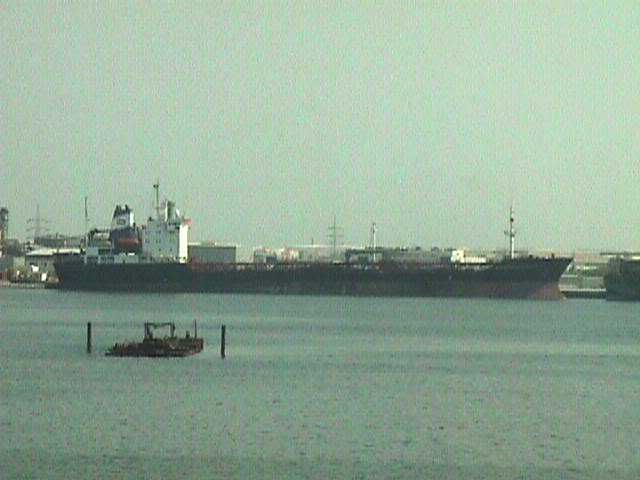
M/V Vladimir Vysotsky, in port Manama, Bahrain, 07 August 1998.
By calling me direct the XO had "jumped my chain of command." In a better Navy, he would have contacted my Division Officer, Mallory, or our Division's Leading Chief Petty Officer, CTRC. The trouble with both of these "superiors" was their morbid incompetence.
CTRC was a weak, nervous little nicotine addict. Mallory was a blazing idiot, derided by all. No shipmate - other than our sycophantic CTRC - ever referred to Mallory as anything but "Mallory." When required to call him "sir" we rhymed it with "cur." Mallory had so sullied his credibility that our Command Master Chief, the Senior Enlisted man on board, referred to any foul-up as "Malloried."
Mallory had selected for our Leading Petty Officer (LPO) his good friend, CTO1. Fraternization was normally frowned upon as a serious breach of Naval discipline. None-the-less, CTO1 did a credible job of checking Mallory's lunacy. Unfortunately CTO1 claimed to hurt his back just before we deployed and was unable to deploy with us. CTM1 became our new, much meeker LPO.
During the period before our six-month, June to December deployment Mallory chose to avoid spending time with his wife and two sons. He preferred to spend long hours in to the night playing computer games aboard our pier-side ship while attempting to fraternize with us.
One night Mallory accidentally locked himself in the vault (Special Compartmented Information Facility or "SCIF") where he had been playing computer games. He was either too dim or too feeble to operate the manual release on the cipher door (helpfully marked "lift here"). In a panic he forgot he could simply use the Emergency Escape Scuttle (a ladder and hatch leading to the deck above). He called down to our berthing and summoned CTR3 to come free him.
Mallory wanted to sell his motorcycle prior to our six-month deployment. An unidentified man lacking collateral approached Mallory and asked for a test ride. That was the last Mallory saw of his bike, demonstrating gross lack of judgment on his part.
My conflict with Mallory started during our first at-sea period on board, Pacific Joint Task Force Exercise 98-1 (PAC JTFEX 98-1), held from 13-24 April 1998, off the coast of California. I discovered Mallory's rat’s nest of classified materials squirreled away in the SCIF. One rule of tactical Intelligence is that any classified document more than two years old is of dubious value, and usually quite worthless. A destroyer lacks the space to serve as a museum or a library. Most of Mallory’s collection was published during the 1970’s and early 1980’s and focused obsessively on the late Soviet Union. I shredded everything dated earlier than 1996: approximately two tons worth of books, charts, and other materials. One document was dated September 1951. Mallory was in a panic and whined insistently. He was unable to physically stop me however.
We deployed 17 June 1998 for the the Arabian Gulf, conducting military exercises and port calls along the way.

Abraham Lincoln Carrier Battle Group (CVBG).

USS Abraham Lincoln CVN-72.
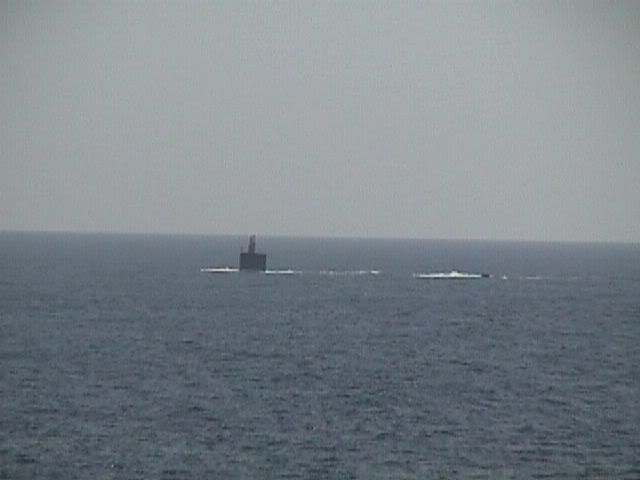
USS Jefferson City SSN-759.
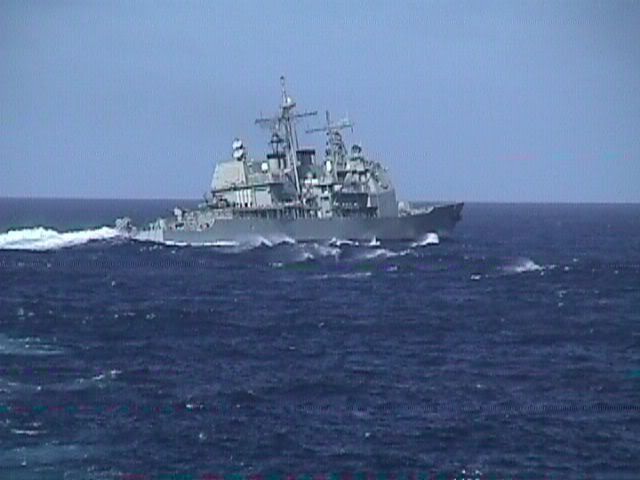
USS Valley Forge CG-50.
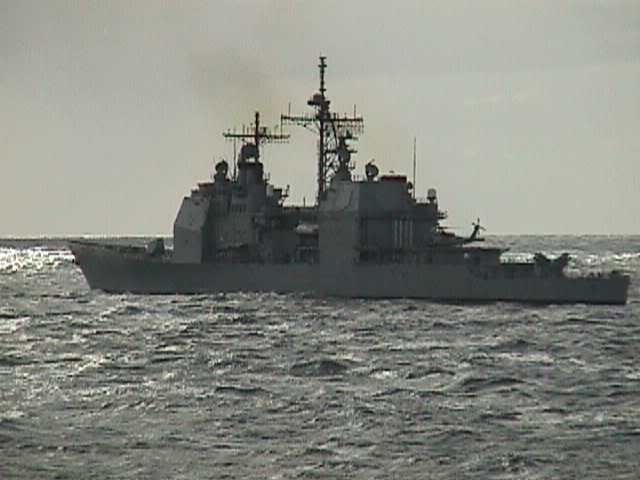
USS Milius DDG-69.
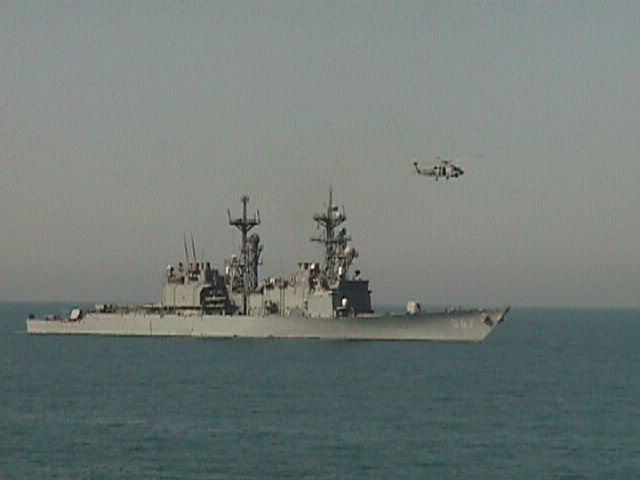
USS Elliot DD-967 w/SH-60B Sea Hawk.
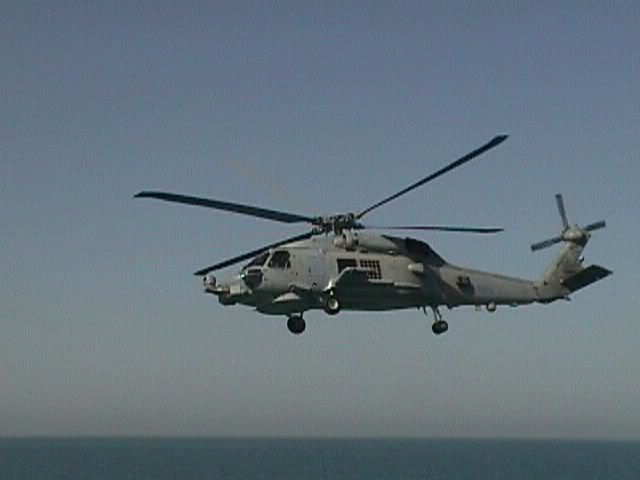
USS Elliot DD-967's SH-60B Seahawk.
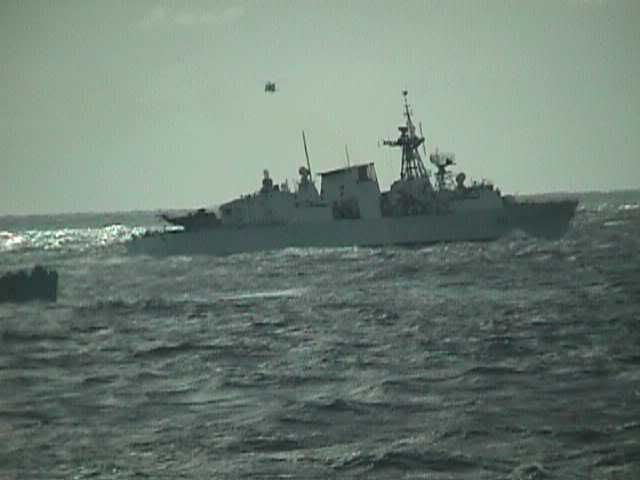
HMCS Ottawa FFG-341.
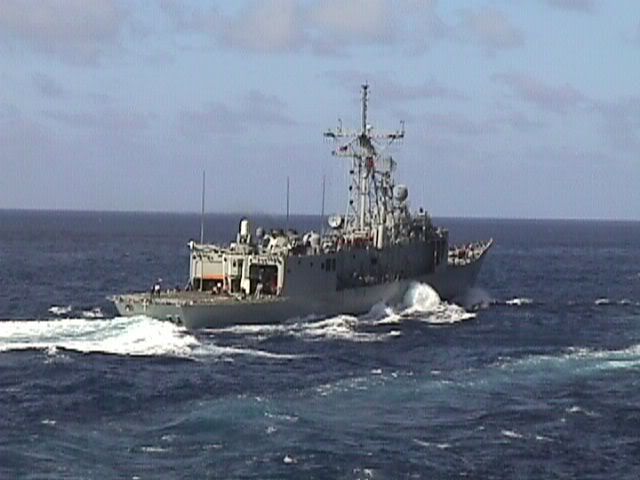
USS Jarrett FFG-33.
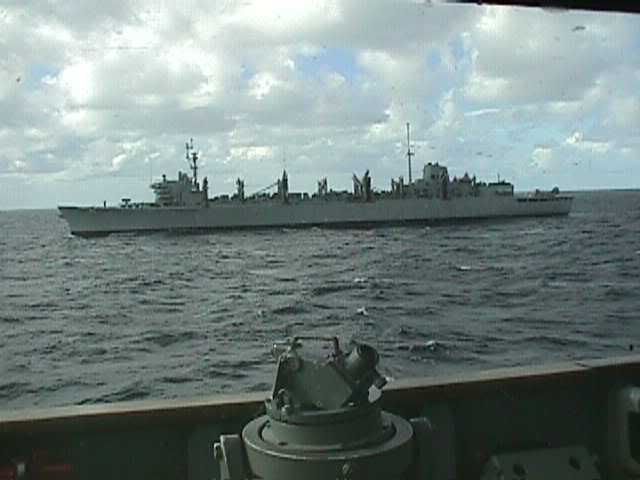
USS Camden AOE-2.
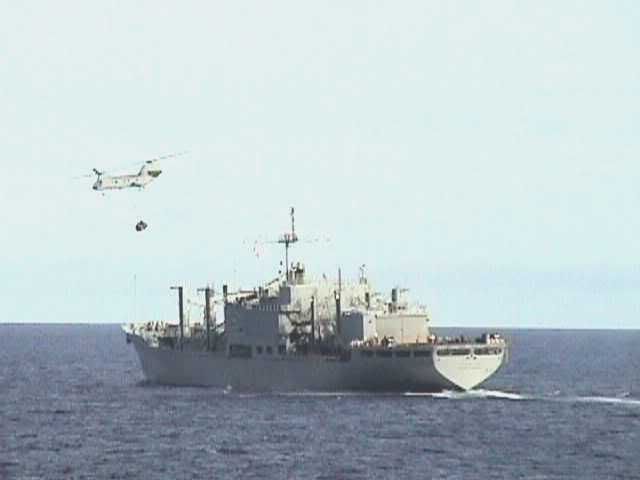
USNS Niagara Falls T-AFS-3.
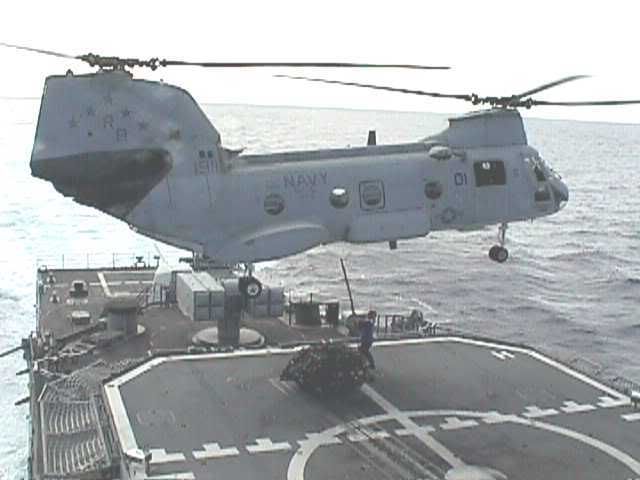
A CH-46 Sea Knight from USNS Niagara Falls T-AFS-3 conducting Vertical Replenishment (VERTREP) w/USS Elliot DD-967.
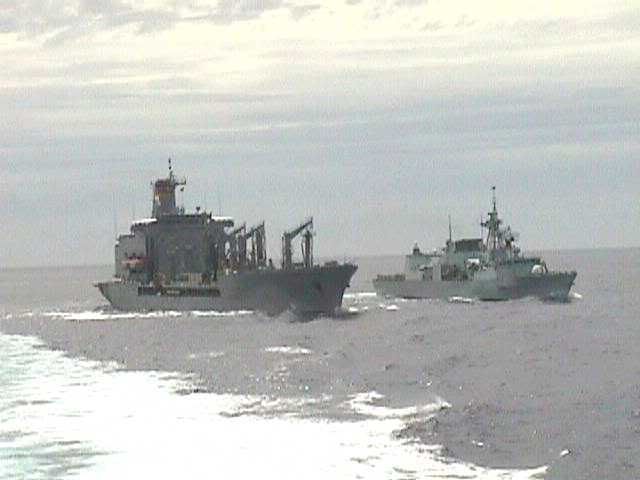
USNS Cimarron AO-177 conducting Underway Replenishment (UNREP) w/HMCS Ottawa FFG-341.
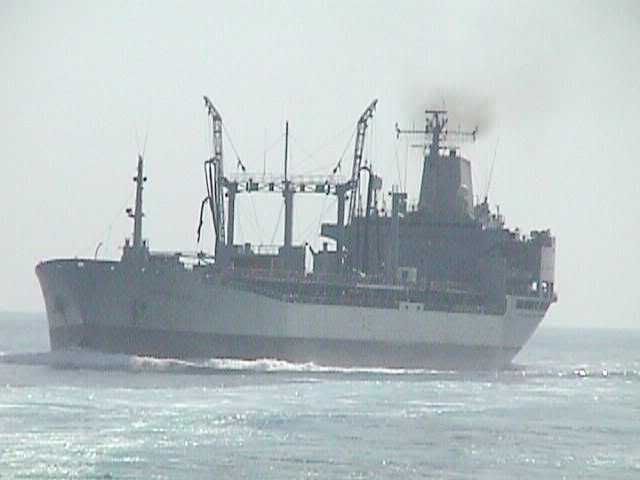
RFA Brambleleaf AOTA-81.
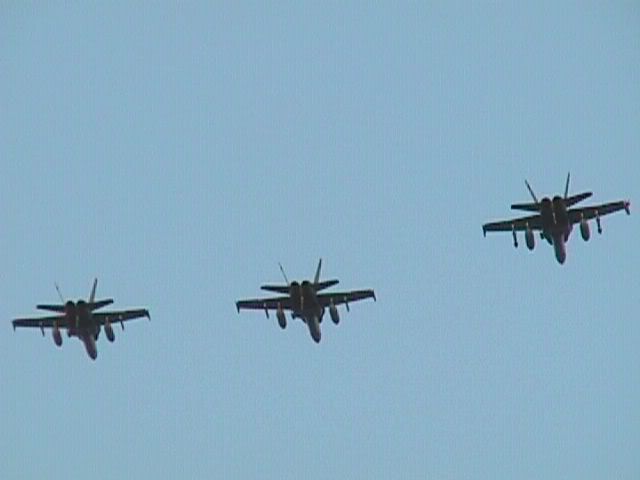
F/A-18 Hornets.
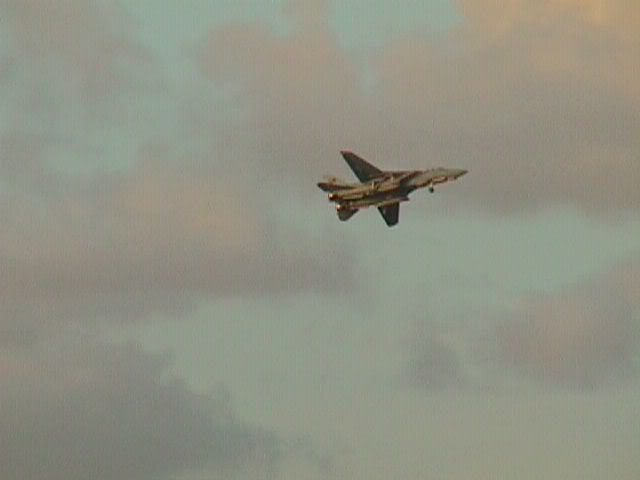
F-14 Tomcat.
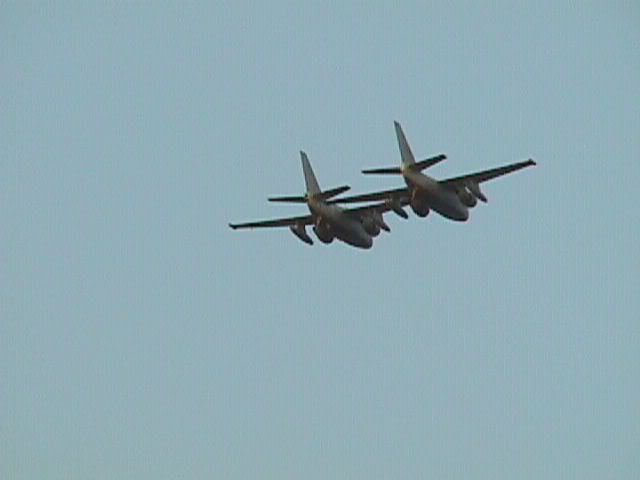
S-3 Vikings.
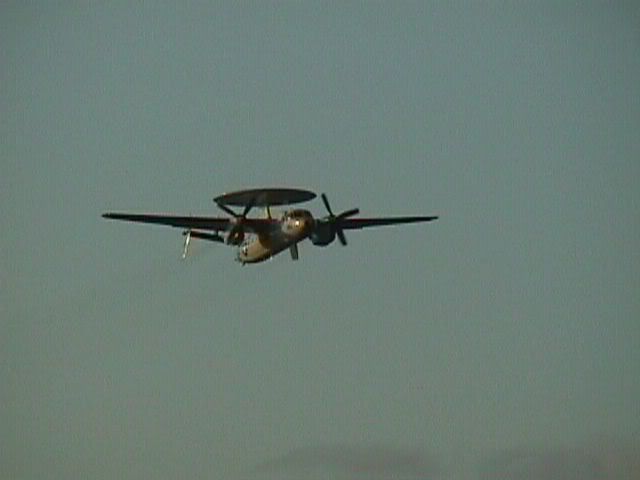
E-2C Hawkeye.
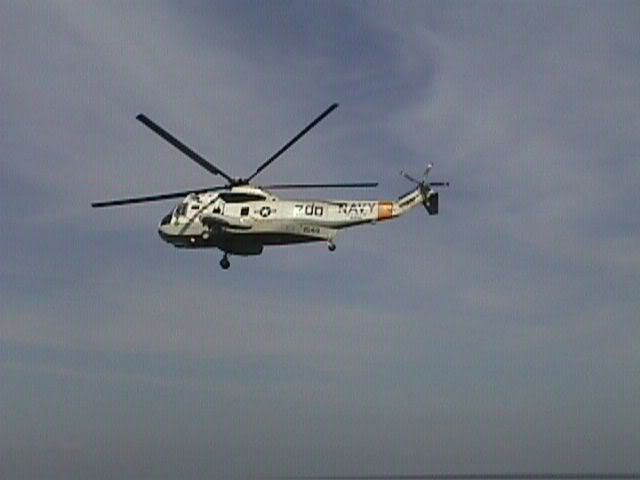
SH-3 Sea King.
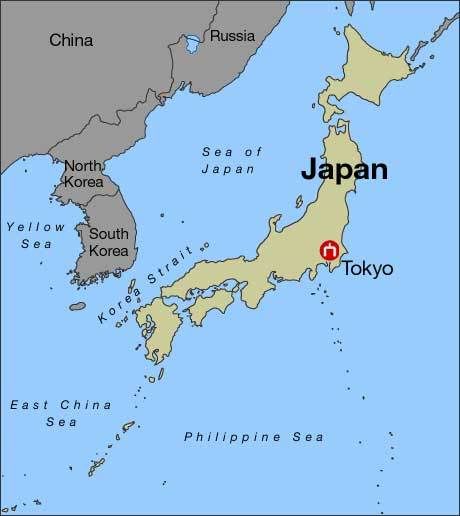
Our first port call I returned to Japan...

...and this time I climbed Mount Fuji (03 July 1998).
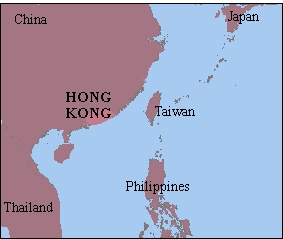
Next was a port visit to Hong Kong - when last I had visited Hong Kong was a British Colony.
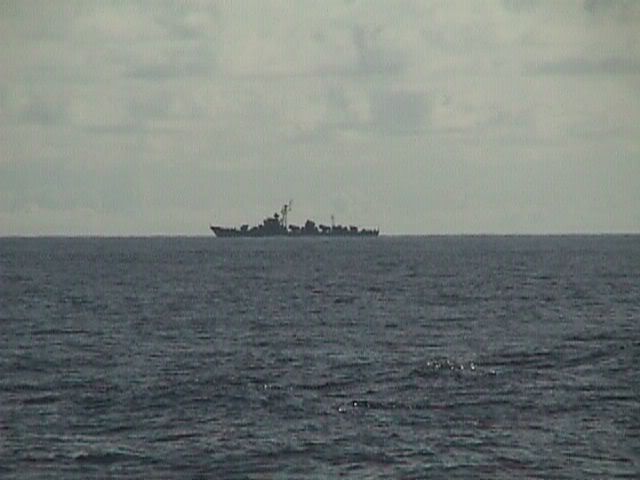
This time we received a Chinese Military escort (a Jainghu I FF-516)...
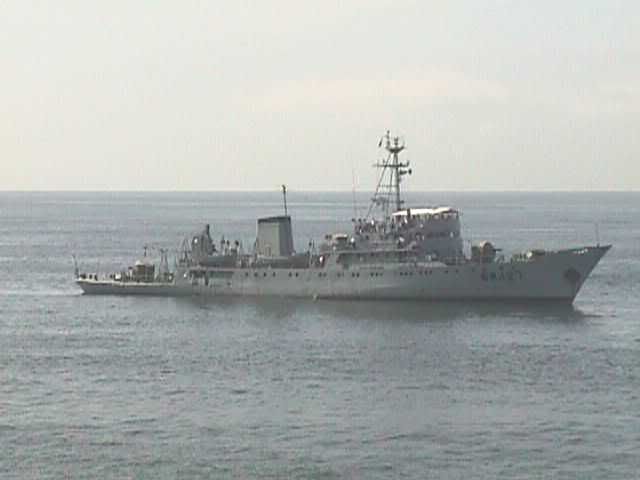
...while a Chinese "research" vessel took a lot of pictures (Yanlai AGS-427).
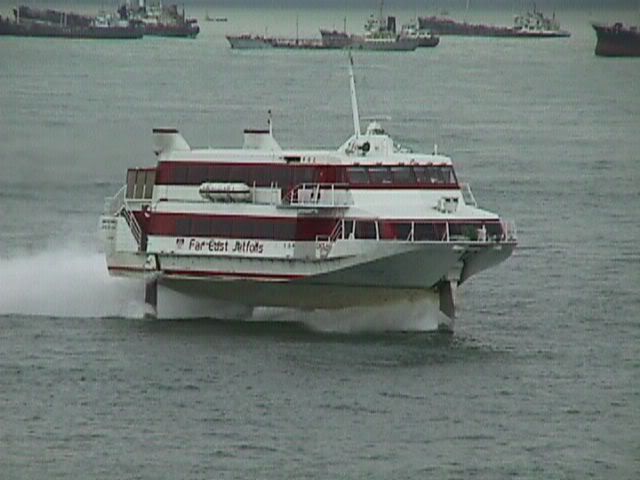
Victoria Harbour still had high-speed hydrofoils...
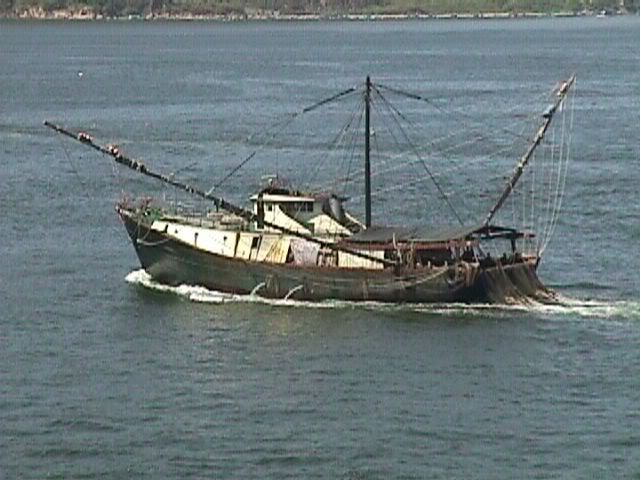
...weaving past plodding junks.
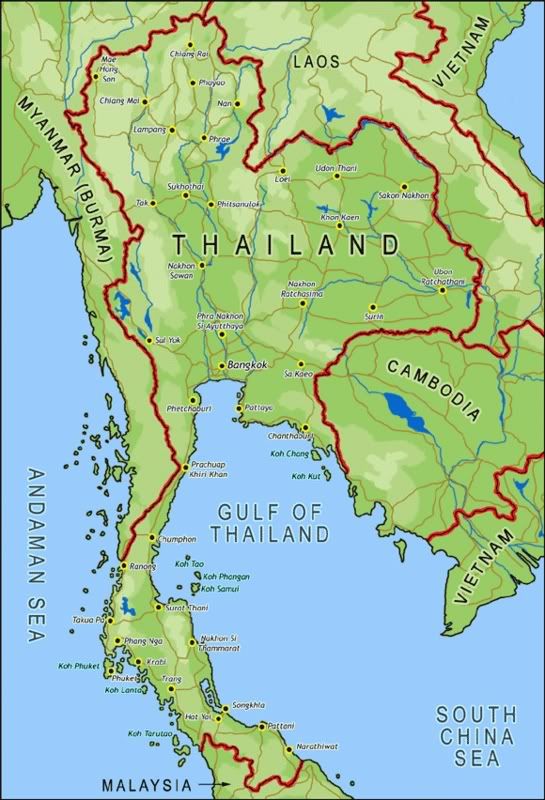
Our next port of call was Phuket, Thailand...
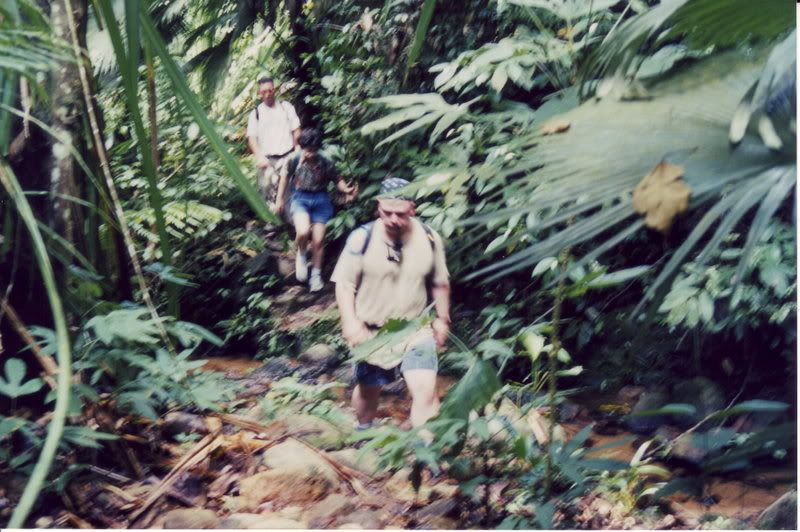
...where I used my "mad tracking skilz" to rescue a group of lost tourists
(okay, really I just followed tracks in the mud).
In Phuket, Mallory stupidly had unprotected sex with a Thai whore, violating his marriage vows, family commitments, and demonstrating again his profound lack of common sense. This was not an officer whom I could respect.
We deployed to the North Arabian Gulf (what everyone else calls the "Persian Gulf") and conducted Maritime Interdiction Operations (MIO). I was on our Visiting Boarding Search and Seizure (VBSS) team. I was Gold Team, Sweep Three. My job was to secure a boarded merchant vessel's superstructure, bridge, and Captain, and provide physical security to our Boarding Officer (usually a Junior Officer) and our Assistant Boarding Officer (usually a Senior Enlisted).
Vessels entering Iraq were stopped and searched for weapons and other military-use contraband. Vessels exiting Iraq via the Shatt-Al-Arab waterway were stopped and searched for smuggled oil or zandee dates. Zandee dates are a delicacy, vice a staple, and grown in orchards along Tigris and Euphrates Rivers. During Ramadan, zandee dates can fetch a higher price than oil. The official concern was that Saddam Hussein might profit from the sale of these dates. That seems silly, now, doesn't it?
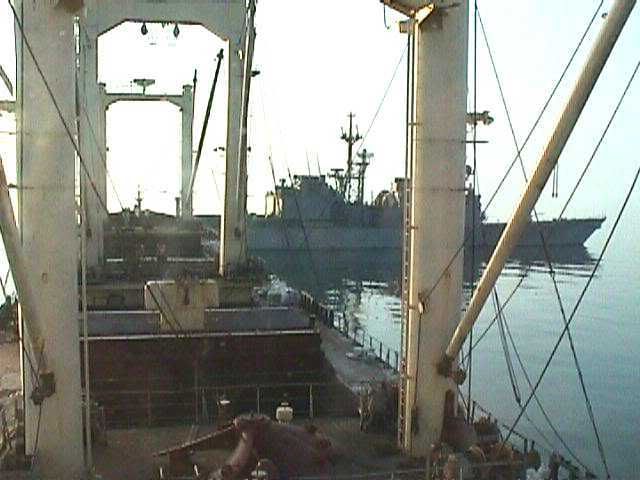
USS Elliot DD-967 from the bridge of the M/V Fixed Star.
Our first boarding was on the M/V Fixed Star, Friday, 31 July 1998. This was a routine and compliant boarding that Mallory was determined to escalate into an international incident. His grotesque incompetence nearly resulted in missed opportunities as he searched ferociously and repeatedly through the Fixed Star’s documentation. Mallory bungled this first boarding so badly that he was never again allowed to lead a team by himself. A second Boarding Officer was added, which removed one of us Enlisted sailors from the team. The Rigid Hulled Inflatable Boats (RHIBs) we used required a three-man crew to operate, leaving room enough for only 15 men. In my opinion, Mallory should simply have been cut from the team.
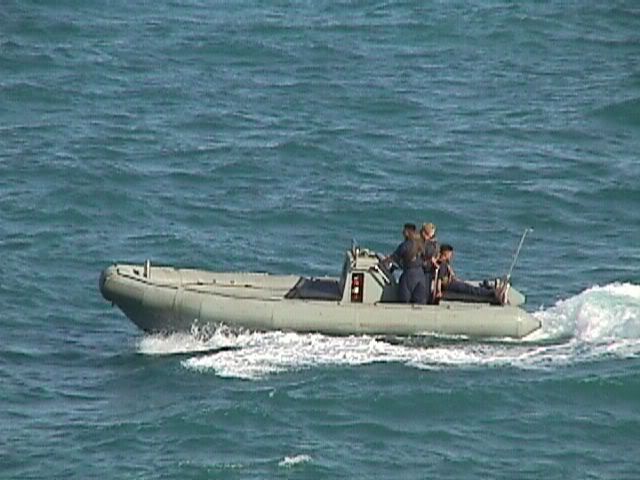
USS Elliot DD-967's Rigid Hulled Inflatable Boat (RHIB).

USS Elliot DD-967 conducting Maritime Interdiction Operations (MIO) in the North Arabian Gulf during the Summer of 1998.
The more we performed MIO, the more we sensed what a racket it was. Ships we caught were sent to a holding area called "Fenway." The smugglers anchored at Fenway as local bureaucrats bid on which Gulf nation would process (and profit from) the confiscated ship and cargo. Once the ship reached the winning port, the crews were released and deported. In too many cases the crews were trafficked and we freed them. The confiscated cargo was auctioned off, as was the captured ship, unless the owner paid a hefty fine. Usually the auctioned cargo went to the smuggler’s broker. The brokers didn’t care to whom they paid their money to as long as they collected the cargo. The smugglers simply bought their ships back at auction rather than pay the creatively exorbitant fines. The bad guys became richer. I earned $18K that year.
The Chain of Command often fancied our ship "The Strike Destroyer" in reference to the Tomahawk cruise missiles we carried on board. "Strike Warfare" is Naval terminology for Power Projection: killing people and breaking things, usually at a safe distance. Our ship was classified as a "Destroyer" (a type of warship originally designed to "destroy" small, high-speed torpedo boats - thus a "Torpedo Boat Destroyer" eventually shortened to "Destroyer"). It became obvious after our high-speed, night-time transit of the Strait of Hormuz in the days following the bombings of two US embassies in Africa that we would play a role in the US response. I briefed the officers and the crew what information was available on Osama bin Ladin, his al Qaeda organization, and his Afghan hosts: the Taliban.
In the spring of 1998, prior to our deployment, I had attended briefings and courses at the Fleet Intelligence Training Center Pacific (FITCPAC) in San Diego along with select officers and crew. Mallory was invited but deemed himself too knowledgeable for "mere" FITCPAC instruction, and choose to skip several critical briefings. Due to this oversight on his part, he lacked the security clearance necessary to learn answers to some of his questions, or to attend a brief the CO called when we received our firing orders.
Our orders were encoded. No one would tell us where our targets actually were - we'd simply enter codes into the missiles and fire them as ordered. Prior to becoming an IS-3105 I was an IS-3921 Strike Warfare Specialist. Due to my familiarity with Strike Warfare, I was able to deduce where our targets were deep in Afghanistan. I briefed the CO, the XO, and two cleared individuals from our Combat Information Center (CIC) in the CO's cabin, and provided the CIC folks with a chart. No one invited Mallory.
One challenge we faced was that in order to strike Afghanistan our Tomahawks would have to fly over Pakistan. Many nations consider it an act of war when cruise missiles penetrate their airspace. The US already suffered political tension with Pakistan: the Pressler Amendment represented a failed US effort to prevent Pakistan from acquiring Weapons of Mass Destruction. Of concern to us was a Pakistani squadron of Dassault Breguet Mirage V’s armed with AM-39 Exocet anti-ship missiles. The Argentineans used an Exocet missile to sink the HMS Sheffield, and the Iraqis accidentally fired a pair of Exocet missiles that seriously damaged the USS Stark. In fact, one of those missiles failed to detonate. Exocet missiles are especially potent against aluminum superstructures.
We expected a poor reaction from the Pakistanis, and we expected them to detect us at any time, thus ruining the chances for a successful strike. Once detected they'd no doubt deduce our purpose in the North Arabian Sea and warn our targets to clear out.
One night the BMOW’s pipe called us to attention over the 1MC then he bellowed emphatically "GENERAL QUARTERS, GENERAL QUARTERS - ALL HANDS MAN YOUR BATTLE STATIONS! THIS IS NOT A DRILL! MOVE UP AND FORWARD ON THE STARBOARD, DOWN AND AFT ON THE PORT! REPEAT, THIS IS NOT A DRILL!"
I grabbed my gear, including a set of keys, and raced to my dark-enshrouded Battle Station: the forward Super-Rapid Blooming Offboard Countermeasures (SRBOC) launcher on the ship’s signal bridge. We had three launch stations aboard: forward, mid-ships, and aft, with a pair of launchers at each station. There were a total of 36 electronically fired mortar tubes that fired flares and chaff (basically plastic confetti). These rounds were designed to fool the guidance systems on incoming missiles, infrared (flares) or chaff (active or semi-active radar guided), hopefully leading to a miss. Some of the rounds weighed 75 pounds - I could handle them easily, and enjoyed doing so. There were four sailors assigned to each station: a supervisor, two loaders, and a sound-powered phone talker. The word came that a squadron of hostile Pakistani Mirage’s armed with Exocet missiles had been detected inbound. As a primary countermeasure position, our battle station was about to become vital in the defense of our home.
I was surprised to find EW2 already there. His dark blue coveralls and very dark brown-skin blended into the pitch black such that I did not see him at first. He had already manned the sound powered telephone and activated the launcher. EW2 had never attended any of our drills. I had only one question: "Are you qualified?"
"I qualified last deployment, IS1" he answered. That would do, and I was glad he had mustered. CTA2, whose battle station was at the mid-ship SRBOC launcher, was the sole CT to man up, and he was already injured. CTA2 had been below decks when General Quarters had sounded. Two herds of Radiomen had panicked, stampeded down the wrong passageway, and flattening CTA2, twice. The whole reason for the well-drilled "up and forward on the starboard, down and aft on the port" standing orders was to avoid pandemonium and injury such as this.
"When in panic, or in doubt, run in circles, scream and shout"
I was the senior man present at the launchers. Woefully undermanned, I decided to leave CTA2 at the mid-ship SRBOCs in case EW2 and I were hurt or killed. Exocet missiles target superstructures - our exact position. It made sense to keep the injured man out of the way, as we were likely to be busy. If EW2 and I were driven back, or more CT’s arrived, the mid-ship position would already be activated and partially manned.
EW2 and I made sure our two launch batteries were ready. The Navy, in its vast institutional wisdom, keeps ammunition locked up to prevent theft or sabotage by us untrustworthy Enlisted men. Adrenaline pumping, I tore the soft metal of the key to the ammunition locker near in half as I twisted it into the lock. I managed to clear the lock, but the key was now useless.
Change of plan: due to my error we could not reload from our position. EW2 passed the word down to the CIC. If a spare key could be found we would hold our position, otherwise we would fall back amidships. CTA2 would be glad to see us. Unable to reload (one key to rule them all in the darkness bind them), after the mid-ship launchers fired, I'd send CTA2 to the aft launcher, while EW2 and I would head to the main deck in order to launch the port and starboard Rubber Ducks (inflatable polyhedron decoys). It was something of a plan any way.
The forward ammunition locker still locked, I ran back amidships to check on CTA2’s injury, and give him the news regarding the locked ammunition, the key I destroyed, and let him know that we were likely joining him. I inspected his injury by the crimson glow of my red-filtered flashlight (another vital item of gear the Navy that does not issue). CTA2’s hand was bleeding where his wristwatch had cut him during one of his falls - a minor but painful injury. Though the cut was deep his tendon seemed undamaged. I was concerned that our dirty flash gear (protective hood and gloves) might cause him an infection. I didn’t need to tell CTA2 to check the launchers: he knew his duty, and had already done so. "As soon as you’re relieved (by either EW2, or the first CT to arrive), head down to the SCIF and get that looked at." The SCIF, where the CT’s were no doubt huddled one deck below us, had a first aid kit. Then I rejoined EW2 forward. I hoped a late arriving CT could bring the spare keys.
We dreading but were ready for the call of "Vampires" (missiles inbound). We were all relieved to hear the BMOW's pipe sound a long blast for "Secure" and the announcement "General Quarters" over the 1MC.
I went tearing below deck to the SCIF to find out what the bloody hell had happened to the CT’s while the rest of the crew raised a relieved cheer into the night, and the CO addressed is on the 1MC. I plowed through the door with necessary emphasis to find all of the missing CT’s gathered there. I cannot describe the abject mortification and misery in their eyes. Mallory had ordered them to stay below decks so that none of them would be hurt or killed defending the ship. CTA2 was a mere secretary by Mallory's reckoning, and therefore expendable, along with EW2, and myself, apparently. I was appalled. Mallory fancied himself a fine leader for protecting his precious CTs.
Mallory had had his fill of me too apparently. At 1900L, 17 August 1998, Mallory stumbled through my door, demanding that I brief him on the upcoming operation. "You’re not cleared", I stated calmly.
"The Captain says I am, and that you’re to brief me", Mallory whined. It didn’t sound like a lawful order to me.
I can be an awkward subordinate, and I refused to provide him with a brief. Mallory regressed into a spoiled toddler, pitching a temper-tantrum, furious that I "wouldn’t do my job", and wounded that I had provided one of "his" charts to the CIC, he referred to me as a "fucking fat-assed kike."
That was too much.
I’m not Jewish, and that’s not the point. Confident that Mallory was physically a coward, I stood in his face. "Stop swearing at me", I demanded tersely, adding rhetorically, "Am I clear?"
Mallory started to say something stupid just then. I roared "AM I CLEAR?"
Terrified, Mallory blanched, trembling and blinking. I was begging Mallory to make a move - any move - which I could construe as an assault from which to defend myself. I’ve life long friends whom have never heard me raise my voice, though I was the battalion cadence caller in "A" school. I can be quite loud, and I'm no pacifist.
"I suggest you call CTRC", I snarled after a moment, keeping my voice low. Mallory promptly complied. I thought this would shut the "kike" insults down right quick.
Later I watched Mallory discuss matters with CTRC on the Harpoon deck amidships. They both seemed upset.
During my rounds next morning the XO called me into his office, asked me to shut his door, and offered me a seat. "I can be an asshole if I have to be", the XO began, then ordered me to take a "round turn on my attitude."
Destroyers are small towns, with roughly 250 people on board. Word of the incident had spread fast. "You know where this is coming from", the XO warned, meaning "straight from the CO", though not straight-forward enough to say so plainly.
"You know what happened?", I asked the XO, knowing well that Mallory was guilty under the Unified Code of Military Justice (UCMJ) of Conduct Unbecoming An Officer and uttering Provoking Speech or Gestures, at a minimum. The UCMJ is sometimes referred to as the "Unorganized Code of Monkey Justice." Bluntly, Rank makes Right, and I lost. No one cared.
"You need to take a round turn on your attitude", the XO reiterated disingenuously.
The XO and CO went deaf, dumb, and blind. Mallory and CTRC began a childish campaign of harassment. CTRC, who took the opportunity to refer to me as a "fucking Jew IS" insisted that Mallory had done nothing wrong, and I'd some personal vendetta he'd not tolerate.
At 2100L, the night of 20 August 1998, General Quarters was called again in order to launch our Tomahawks. We were not required to man our battle-station, as our position was exposed to the toxic fumes from the Tomahawks. Most of the crew, in fact, was invited to watch the Tomahawks from the fantail (aft area of the ship).
I found EW2 manning the Electronic Warfare shack, and joined him for a moment. He'd earned my respect, based solely on the fact that we showed up when most had not. We did not share in the crew’s emphatic jubilation at our mission. He declined my offer to relieve him so that he might watch the Tomahawks from the fantail too. "You know we’re killing people?" EW2 asked quietly. To his credit this bothered him.
"I know", I nodded grimly. Murdering humans seemed an odd thing to celebrate, even if the enemy was terrorists. It bothered me, too, that we were fighting as cowards fight: hurling Tomahawks from a thousand miles away into the dead of night. "I'm going to head aft", I told him. "After the first few Tomahawks launch, I'll come back here to see if you've changed your mind. Tonight you'll have the opportunity to see a sight most people will never see. You might later regret missing that." The word "opportunity" seemed to resonate with him. I was offering him the chance to be just like anyone else on board. I know that racism never went away. Especially in the Navy, overt racism simply morphed into something else insidious.
I watched the first four Tomahawks as the crew gathered on the starboard fantail rail. My shipmates were boisterously and repeatedly singing "Shananana Shananana Hey Hey Hey Goodbye." I didn't join in the chant, though I kept my word and relieved EW2.
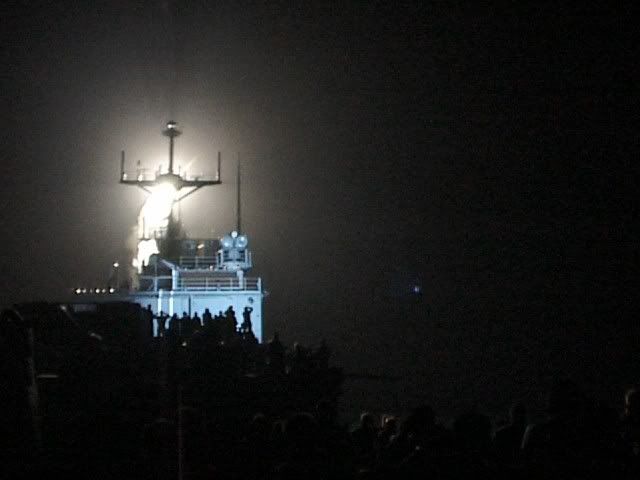
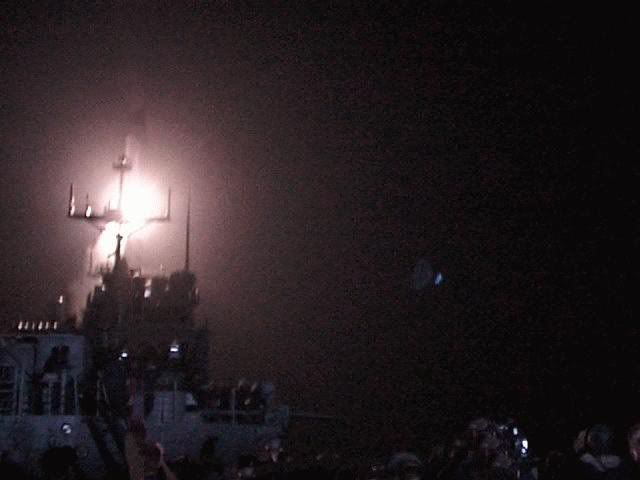
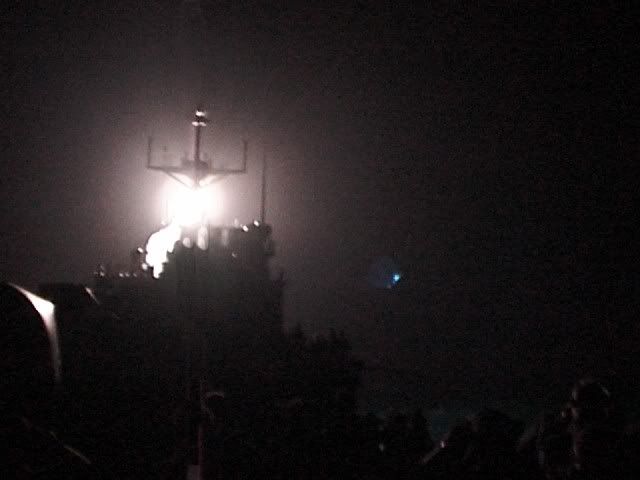
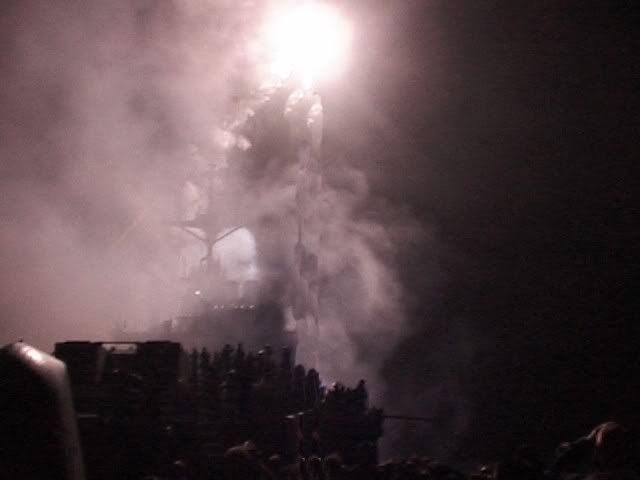
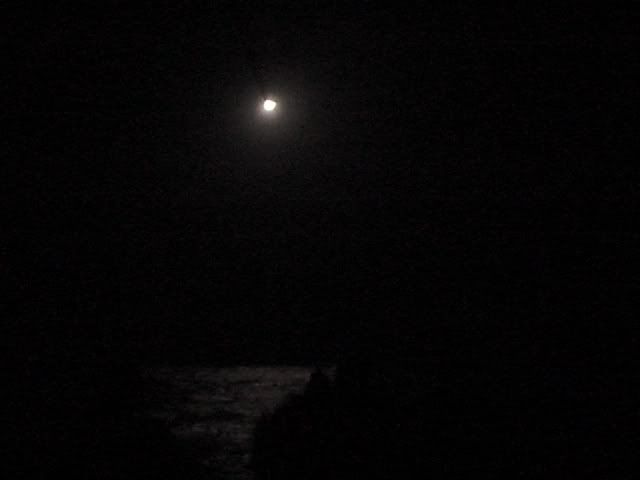
Strategically the operation hadn’t made much sense. A better choice would have been to launch the Tomahawks from submarines. Worse, we loitered in the area for over a week. On Thursday, 27 August 1998, a Pakistani Maritime Patrol Aircraft finally flew against us, perhaps overwhelmed by the curiosity of our loitering off their coast in the North Arabian Sea? So much for Operational Security (a.k.a., OPSEC) or "secrecy."
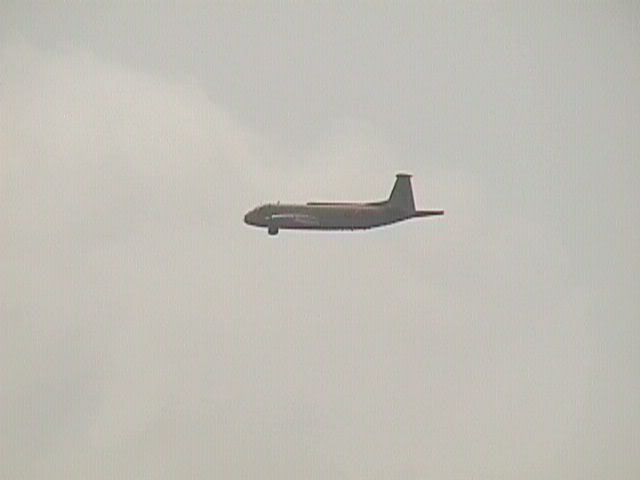
A Pakistani Dassault Breguet Atlantic, 27 August 1998.
Our cover irrevocably blown, we finally headed back into the Gulf. Mallory "reorganized" our division, taking away my office, desk, and computer. He had CTM1 throw mindless busy work my way. In one instance Mallory insisted that I clean out a safe that CTM1 himself changed the combination to, and kept the new numbers from me. Unable to access the safe, I was unable to comply. A policy of gross stupidity became the order of the day. Luckily, after two days, CTM1’s attention span was exceeded. Nicotine held a greater attraction for him than baby-sitting me.
Suddenly I was officially fat. Not one month previously the CO had noted I had actually lost weight since the deployment began. "You’re uniform is hanging off of you, IS1", he commented prior to one 1800 daily wardroom brief. "Did the ship’s laundry make your uniform larger?", he joked.
"I don’t believe the ship’s laundry has ever made a uniform larger, sir", was my answer, drawing a good-natured chuckles from around the wardroom.
I had passed all my Physical Readiness Tests (PRT) and complied with Navy Body Fat measurements, but was now ordered to attend Physical Training (PT) every morning at 0530. Indeed, I had once been officially recognized for my physical readiness, with a letter of Commendation signed by Rear Admiral Briggs. QMC, the PRT director, openly admitted the Chain of Command was "fucking with me." After the second day, no one else attended the morning PT session. I kept at it though. This became my morning constitutional, walking a few laps around the weather deck, cheerfully waving up to the bridge crew whenever they noticed, then heading below decks for breakfast.
I mortified everyone when I started to turn in at 2100L (9PM). CTRC "counseled" me, with a silent CTM1 as his witness, insisting that I put in longer hours. This was hypocritical, considering CTRC's lack of work ethic - his idea of work included a half-hour smoke break every 45 minutes. I laughed at him when he held up CTM1 "work ethic" as an example: every man in our berthing knew CTM1, besides his own frequent smoke breaks, indulged in a four-hour nap every afternoon. If I worked based on that work ethic, nothing would get done at all.
My evaluations became full of nonsense and lies. Promises were broken, and awards were withheld, too - oh, boo hoo. Despite my Chain of Command’s bumbling interference, I completed my duties as best I could.
There were two types of boardings: compliant and non-compliant. A non-compliant boarding was interesting in that we took the vessel by force. Our first non-compliant boarding was Wednesday, 02 September 1998, against the M/V Nurani, a dhow that had been caught smuggling and sent to Fenway. It had been our turn to mind this holding area. The Master of the M/V Nurani, and Indian National - dot, not feather, had got it into his head that if he simply dumped his cargo of smuggled oil into the sea we’d have to let him go due to lack of evidence. It doesn’t work that way.
Mallory and CTRC had removed me from the VBSS team. The CO insisted that I join the VBSS team storming the M/V Nurani over the objections of both of them. Over-ruled, they failed to pass the word to me until it was too late to draw a firearm from the ship’s armory. I took my personal weapon, an armor piercing knife (Cold Steel Recon Tanto), and joined the team in the RHIB.
We took the M/V Nurani simply enough. Normally we herded crewmembers to forecastle (bow) while the Captain stayed on the bridge and the chief engineer stayed in the engineering spaces. The M/V Nurani was too small for that, however. The M/V Nurani had a deckhouse aft that served as both crew quarters and bridge. An outdoor galley, exposed to the weather, was situated aft of the deckhouse, and an overgrown wooden bucket with a hole in the bottom was slung over the starboard side for use as a lavatory.
We secured the dozen or so M/V Nurani crew portside of the deckhouse, while the Boarding Officer - a real one, not Mallory - chewed out the disgruntled Captain on the starboard side of this structure. In fact, both Mallory and CTRC stayed aboard our ship. I toured the M/V Nurani alone, forward along the portside, aft along the starboard, taking photographs. The dhow was in sad condition. Steel slabs had been welded together to form a score of makeshift tanks, approximately the size of dumpsters, filling the ship. A recently secured pump was attached to one tank, with hoses running overboard towards an oil slick surrounding the vessel. Once upon a time the M/V Nurani had been a beautiful dhow. I noted her sleek lines, and delicate flower patterns intricately carved into her woodwork.
As I headed aft from the bow along the M/V Nurani’s starboard side, I noted the dejected Captain staring at a blanket on the deck, maybe three paces from him, out of the Boarding Officer's line of sight. There was a half eaten grapefruit there, and a knife. Someone had been eating a snack, recently, while monitoring the pump's progress by my guess. I could hear our Boarding Officer criticizing the Captain’s stupid decision and reckless action. The Captain made a move for the knife and I stepped into his way. He would have to get through me to get to his weapon. I stopped and took a photograph of the knife. He cast his dark eyes down, refusing eye contact with either our Boarding Officer or with me.
I recorded details I'll not bore you with here. My report of the incident received a "High Value" evaluation from the Office of Naval Intelligence (ONI). This praise was well received by my chain of command, and I was happy to share the credit. Very many outstanding Intelligence professionals, especially Enlisted, never receive any "High Value" evaluations, which indicate Intelligence reports of executive level import (e.g., briefed to the President). This was my ninth such evaluation. I was reinstated on the VBSS team from that day on.
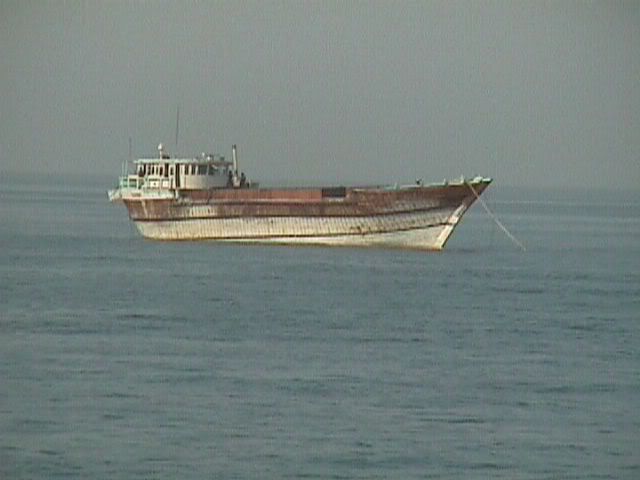
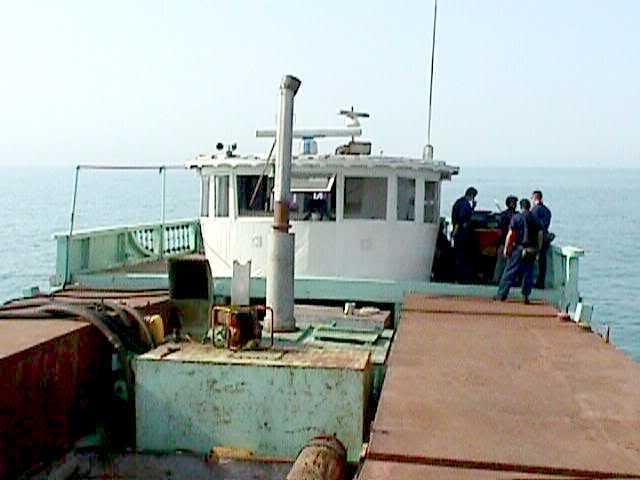
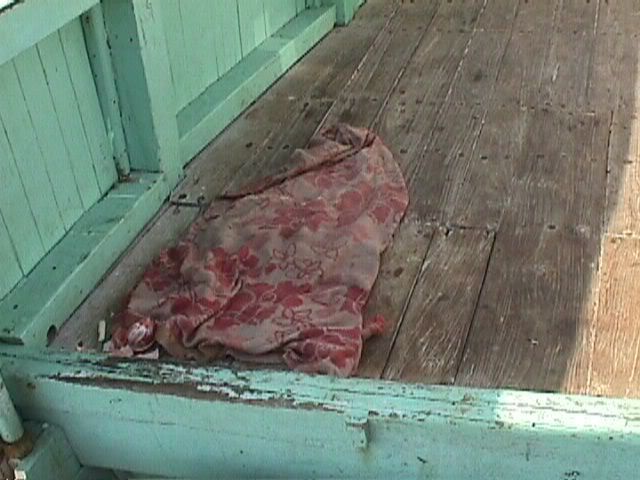
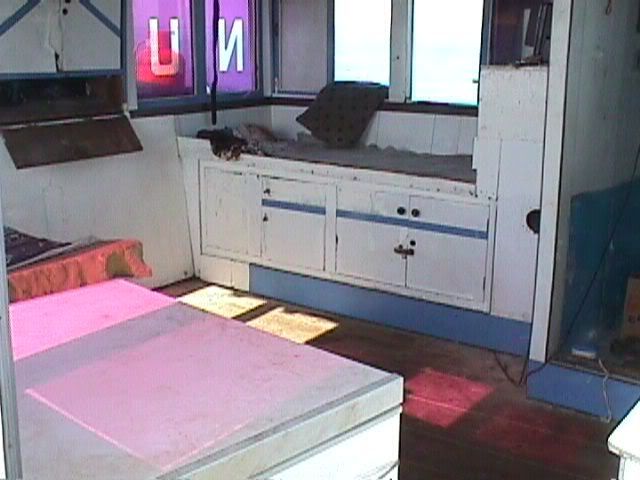
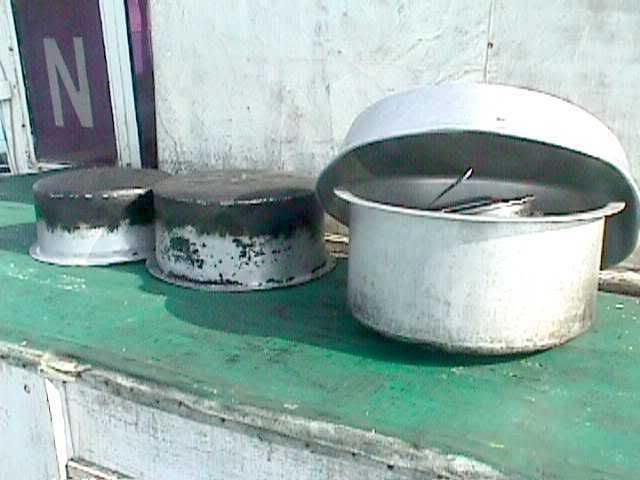
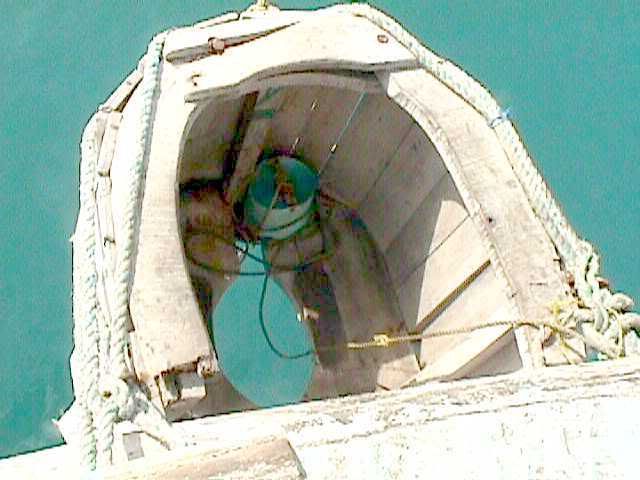
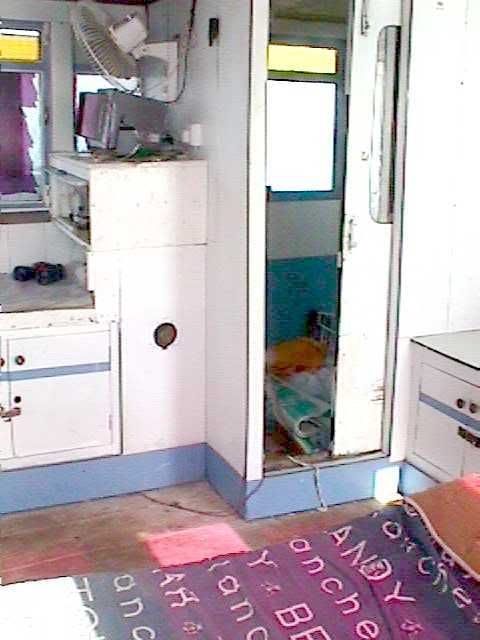
M/V Nurani.
I thought the CO still treated me professionally. On Saturday, 12 September 1998, we sighted a known smuggler, the Off-Shore Resupply Vessel (OSRV) T-2000, in international waters. The CO and I stood shoulder-to-shoulder on the port bridge wing, scrutinizing the details of the contact. The CO told me directly that he wanted me on the boarding team that took that ship - no mistakes or "miscommunications" from the incompetent Mallory or CTRC this time. We were waiting for the "go" from Headquarters when, unexpectedly, Central Command (CENTCOM) denied our request to board the smuggler. We've no idea why.
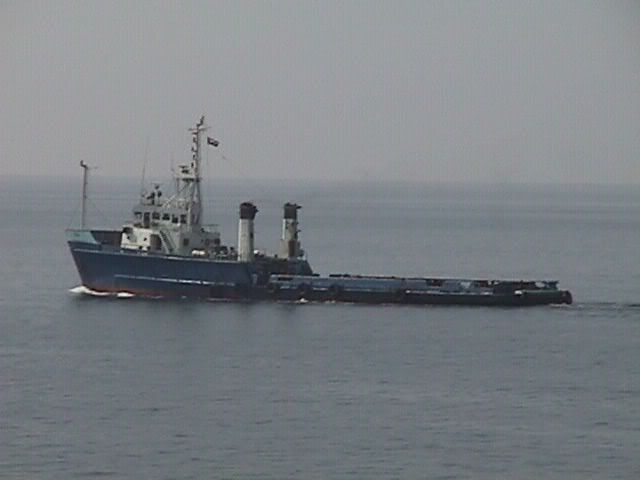
The OSRV T-2000, 12 September 1998.
We did board several other ships over the course of the next few weeks, though we also became aware that much of the Intelligence we had was inadequate. On Saturday, 10 October 1998, we were all looking forward to a few days in Dubai, United Arab Emirates. The Federal Government starts its fiscal year 01 October. With the new fiscal year had come a new change in our reporting procedures: CENTCOM no longer wanted us to send "Locater: Black" messages to describe merchant vessel contacts. Aye-aye. However, as we approached Dubai, I spotted the Russian-flagged tanker M/V Viktor Kibenok, a vessel that was suspected of smuggling and was, at that very moment, reported by Headquarters as anchored in the Shatt-Al-Arab waterway, at the other end of the Gulf.
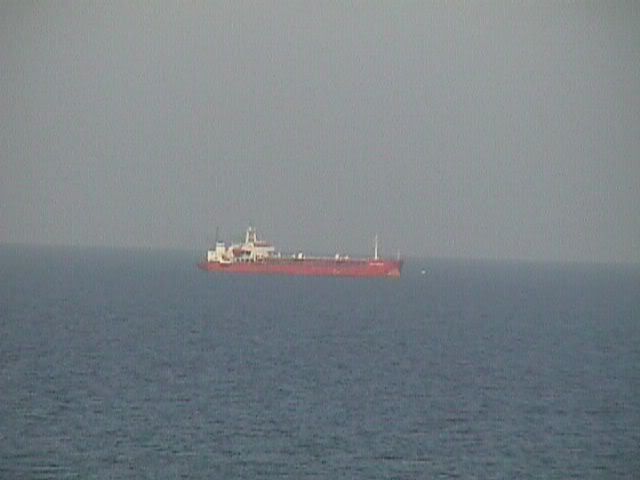
M/V Viktor Kibenok, Dubai Anchorage, 10 October 1998.
As the crew bolted down the gangplank for some well-deserved liberty ashore, I stayed behind to catalog and report the other ships in port. One wreck sunk just inside Dubai's breakwater was the Ukrainian-flagged M/V Inhenzer Guleyev, also reported by Headquarters as a suspected smuggler presently located in the Shatt-Al-Arab waterway.
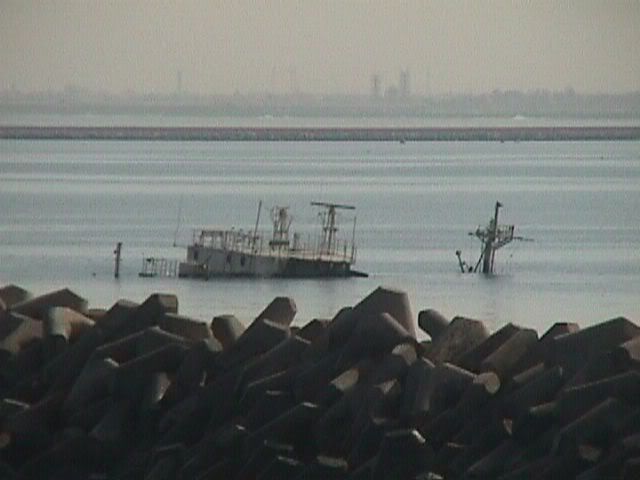
M/V Inhenzer Guleyev, in port Dubai, Saturday, 10 October 1998.
I generated a "Locator: Black" knowing the information correcting Headquarters was important. The new reporting system was unavailable to us. We'd catch heat, but we'd get the word out too. The CO agreed and released the message. Surprisingly, only one Staff-weenie cried over the violation of his precious procedures. We collected a few more Bravo Zulu's ("BZ's" or "atta-boys"), and Headquarters reluctantly changed their assessment. A second look at the suspected contacts in the Shatt-Al-Arab waterway revealed Headquarters had been reporting the wrong names on the wrong ships, confirming our suspicions.
A week later, Saturday, 17 October 1998, I was on the VBSS team that boarded the M/V Sea Joy - our last boarding for the deployment, and a compliant one too. We'd boarded 25 ships in total, 13 of them non-compliant: a rather small number, all-in-all.
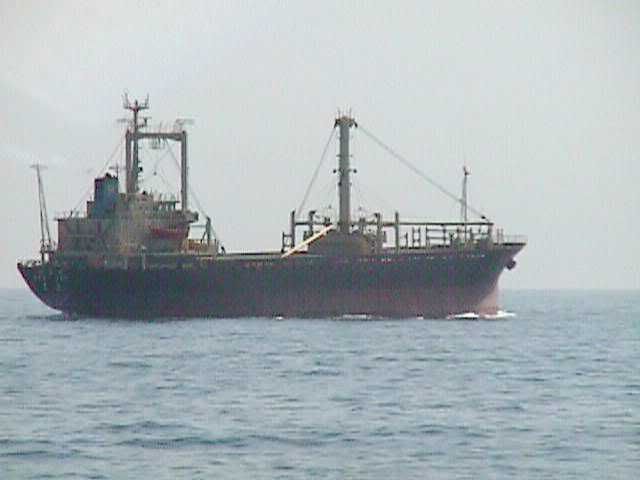
M/V Sea Joy, Saturday, 17 October 1998.
As we departed the Gulf, I noted that Headquarters was once again reporting the M/V Inhenzer Guleyev as an active smuggler in the Shatt-Al-Arab waterway. I had to wonder if letting the OSRV T-2000 go had any connection with the poor Intel.
Our first port call after leaving the Gulf was Bunbury, Western Australia. Bunbury is a small, seaside city in a fairly rural setting. We were off season in this resort town. I rented a bike and a room at a hotel by Bunbury’s old lighthouse. The Australians were friendly all around. The girls liked our accents and chased us - not that anyone ran. We liked their accents too.
I volunteered to give ship tours on my duty day - a duty I enjoyed. Crowds of eager Australians came to walk our decks and take photographs. I recall one group of young people fondly. They were mostly between the ages of 11 and 13, and mostly girls. One of the older girls, a tall blond firebrand name Sam, fancied my ball cap which she soon collected. Another little dear asked urgently if we had a "loo." I was confused. Luckily she asked again: "loo" and I realized she needed the head, as in lavatory. I escorted her below deck to the nearest head, and stood guard in the passageway. I pondered while waiting that no one seemed upset by this, and imagined the pandemonium taking a minor girl below decks would cause back in the US.
What I really remember from that particular group of young ladies was the look on their faces when I introduced them to one of our helicopter pilots - a very attractive young brunette Lieutenant, one of only three women onboard. The Lieutenant briefed the group and answered questions regarding her helicopter. Several of the young Aussie girls stood there with dropped jaws, as if they’d never seen a woman military helicopter pilot before. I smiled as I distinctly heard the sound of an imaginary barrier being shattered.
I got together with a few buddies and rented horses out in the countryside. Zoey, an attractive girl with light brown hair, met us in town to take us to her mother Lisa’s station. She warned us her little sister, Georgette, was just 16, and very excited to meet American sailors. Zoey’s grandmother was there too. Her father flew helicopters, and was away. We assured her we’d behave, and spent the best part of the day pleasantly exploring the country-side on horseback.
We also explored Margaret River, went on a wine tasting tour, visited a raptor sanctuary, and ventured into some caves. We even spent some time at a beach with huge waves - an ideal surf spot I imagine.
For my last PRT, held during a port call in Albany, Western Australia, early-November 1998, I snubbed the program by doing the bare minimum to pass - a first for me. Normally I maxed out the push-ups and sit-ups, and turned in a decent run time. What the Chain of Command did not yet know was that this would be my last PRT in the Navy. A mistake in my orders had transferred me to the ship with only 13 months left on active duty. I should have been forced to extended for at least 11 more months when I accepted orders. However, the Navy forgot, and I didn’t mention it. I did the bare minimum of push-ups and sit-up, and walked most of the way on the "run." I still beat people across the finish line.
We sailed across the Great Australian Bight into Melbourne, Victoria, Australia. I rented a room at the Victoria’s Arms downtown, and spent a day or two happily exploring the city. Having done this on a whim, I wasn’t properly packed. I actually went clothes shopping - a rarity for me, and had a pleasant time of it. I found a pair of socks embroidered with duckbilled platypuses amusing and bought a pair. Even in a large city like Melbourne Australians are remarkably friendly.
At a green and pleasant park the next day I encountered a young lad, seven or eight years old, with crippled legs. He reminded me very much of my childhood friend Stuart Odom. His mother held him as he sat on a fence watching his little brother, age four perhaps, navigate a miniature English village. "Hello," he called out. "I’m Brian."
He was a little chatterbox. There was no stopping him. As I bade him and his family farewell he sighed. "This has been a good day" he reckoned, "even if the zoo isn’t open."
He was right, I saw. A sign posted nearby indicated the zoo was closed.
"Do you know what I really wish for?" he asked. I hesitated, imagining I knew what a little boy with crippled legs watching his little brother run around might wish for. I was wrong.
"What I really wish for is to have seen a duckbilled platypus today."
I hiked up my pant leg to display the duckbilled platypus on my sock. He was delighted. He dubbed them "magic socks!"
A few friends and I explored the Grampians too. We boarded a tour bus, and were delighted to find some Yanks in the crowd. Angie from Long Island was visiting her sister TJ, an American student in an Australian college.
Soon after departing Melbourne we were caught in a storm off the coast of Australia, on Friday, 13 November 1998. At 0400 Local we were hit by a rogue wave that caused extensive damage. Of those sleeping in the forward 54-man Operations Berthing, only EW1(SW) and I awakened. Investigation revealed extensive damage to our outer hatches and our forward starboard superstructure. Water damage went down five decks. The motion of the ship agitated the flooding in a storeroom containing lagging material, resulting in the bulkheads being coated in a fine mist of cardboard and lagging pulp. I took these images a few hours later, around 0730 local, after sunrise. The seas were still rough.
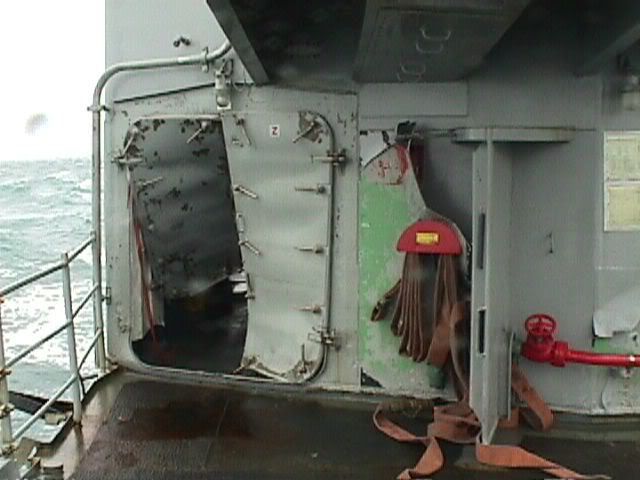
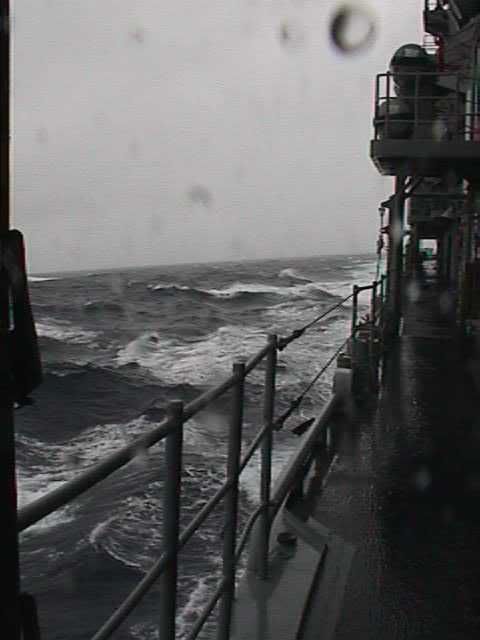
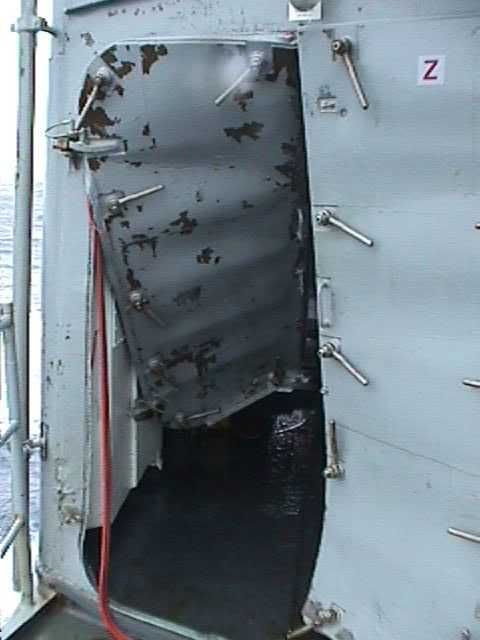
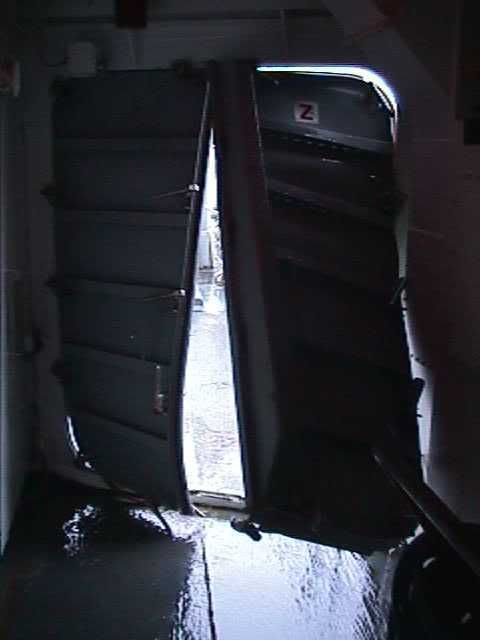
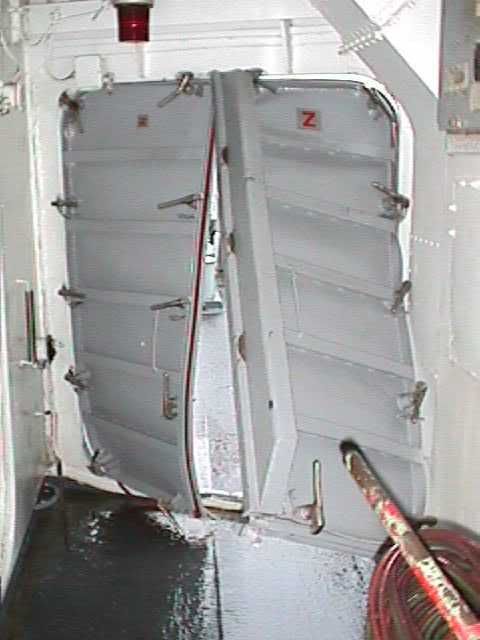
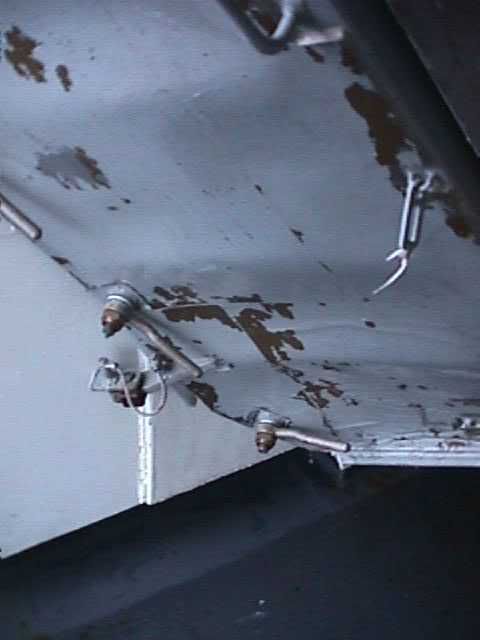
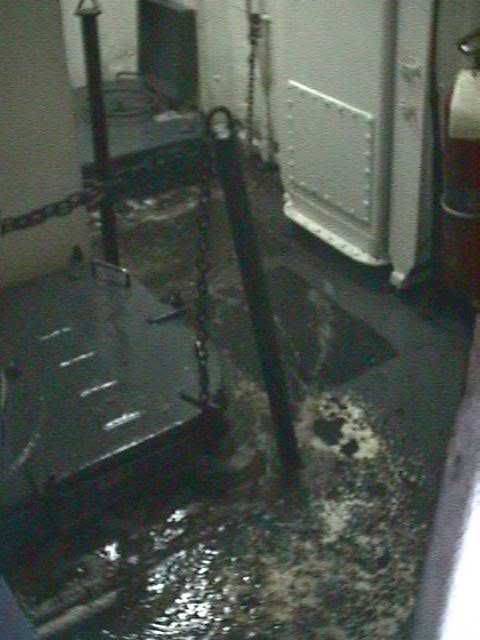
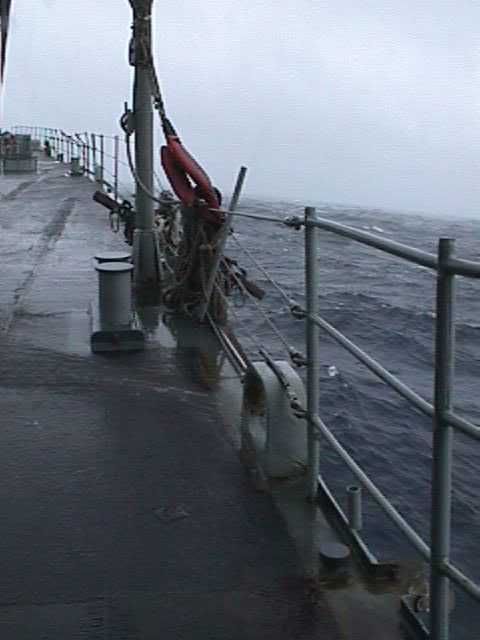
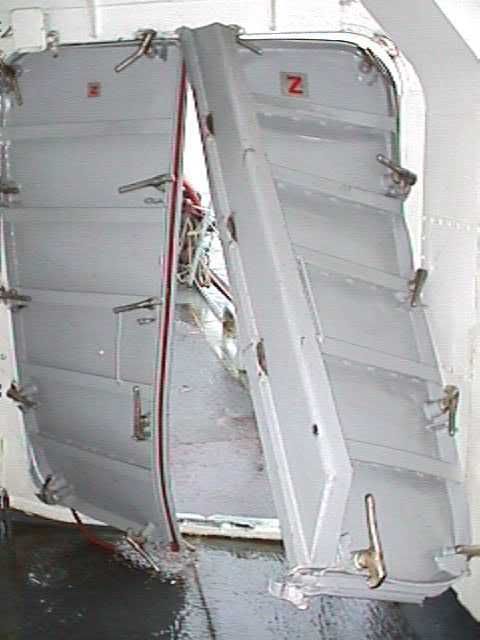
The damage necessitated an unscheduled port of call in Pearl Harbour, Hawaii. We arrived on 30 November 1998, and spent one night. Almost half the crew departed Elliot in order to vacation with family who'd flown there or to fly home early themselves. I was proud to have been a part of something larger than myself, though the memorial over the remains of the USS Arizona BB-39, sunk in the surprise attack by Japan on 07 December 1941, reminded me that others did more, and others gave more. The USS Missouri BB-63, on whose decks the Japanese had signed the surrender documents ending the Second World War also caught my eye. Together with the Arizona, my shipmates took to calling the two ships the Alpha and Omega of the last "good" war. I don’t see things as simple as that.
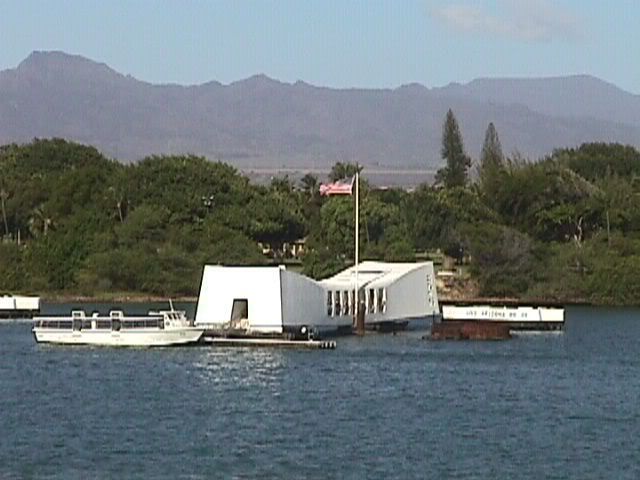
USS Arizona BB-39 Memorial.
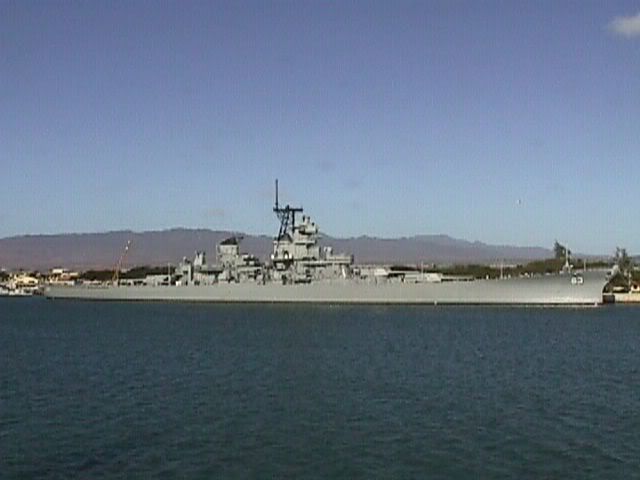
USS Missouri BB-63.
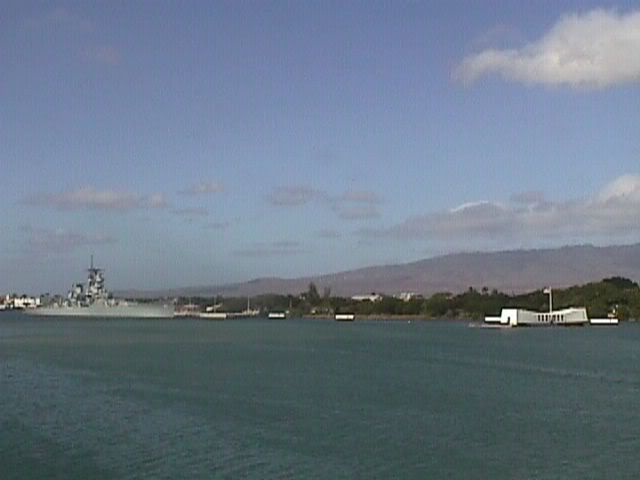
USS Missouri BB-63 & USS Arizona BB-39 Memorial, Pearl Harbour, Hawaii.
My maternal grandmother died the day we arrived in Pearl Harbor. My Chain of Command received word that night via an American Red Cross (AMCROSS) message. We sailed the next day. After we put to sea, the XO called me to his stateroom to deliver the news. I have to wonder why he chose to wait until we put to sea in order to pass the word? Did he wish to prevent me from flying from Hawaii to attend her funeral? Flying from Hawaii would have been easy and cheap: the military flies in and out routinely, several times a day - transporting vacationing Senior Officers usually.
I suspect that the XO enjoyed telling me the news as he offered some lame excuse as to why I couldn’t attend my Grandmother's funeral. My father had taught me to never show weakness to an enemy, so I kept my reaction cold.
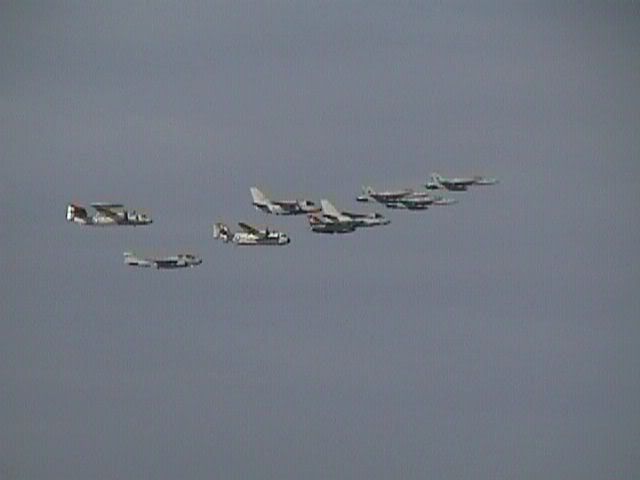
We returned to San Diego on 07 December 1998. The Point Loma Lighthouse overlooking the entrance to San Diego Harbour was a welcome sight. Eager family and friends of my shipmates gathered expectantly on the pier. New fathers were let down the plank first, followed by officers and crew in order of rank. I watched loved ones greet each other joyously. There was no one there for me. All of my deployments had ended at an empty pier.
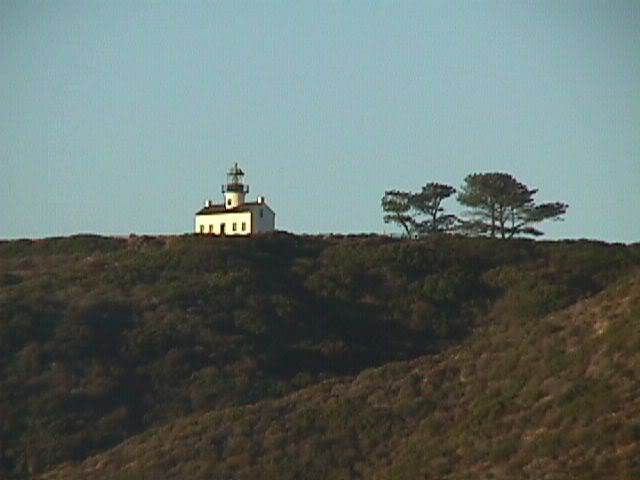
Point Loma, San Diego, California - a welcome sight!
The end of my enlistment - my End of Active Obligated Service (EAOS) - was 05 March 1999. I had 45 days worth of leave, and put in for Terminal Leave starting 17 January 1999. I don’t think my Chain of Command was pleased.
Despite several weeks notice, the Ship’s Office curiously failed to process my paperwork. On Friday, 17 January 1999, I secured, despite my "missing" leave papers. On Sunday, 19 January 1999 (e.g., when most of the Chain of Command wasn’t aboard), a buddy of mine "found" my missing leave papers. We recorded this in the ship's log as a matter of record.
My plan had been to return to New England from San Diego, and while still getting pay find a new job. The XO ordered me to remain in San Diego County. He also ordered me to stay clear of the ship and crew, as I was returning everyday in order to collect my discharge (DD-214). Thus I became homeless while on active duty. The XO also thought it wise to insult my blue-collar appearance, comparing me to the shipyard workers in port. I remained proud of my proletariat authenticity, a thing he will never possess. The XO told me I couldn’t leave San Diego County until the CO gave me an exit brief. The CO dallied until 03 March 1999, just two days prior to my EAOS.
The CO did a credible job of taking my "exit brief" seriously, pretending that I was an outstanding IS, who had kept his command well-advised, and commenting that I "always had the right answer at the right time." He offered to write me a letter of recommendation for any job I might find. Having read the Evaluations he had signed off on me, that wasn't going to happen. I was tired of his lies.
As I stepped from the CO cabin CTRC collected my ID card. I wouldn't be needing it any more. I told him I wasn't even Jewish, and his jaw hit the deck.
As I walked down the gangplank the final time, only CTM1 and CTA2 were there to see me off. I’d worn my working winter blue uniform, which included a tie. CTA2 admired my destroyer-shaped tie-clip, so I gave it to him. He was pleased, and a little sad. He called me a good man, and I believed him sincere. Both CTM1 and CTA2 shook my hand.
I had surreptitiously received a copy of my service record, quite thick with documentation of what a horrible waste of humanity I am. Of all of the many pages only two sheets had caught my eye: a pair of written statements therein, each containing lies. One was signed by CTA1, the other by CTA2. I wasn’t supposed to have seen these documents. It's likely they were ordered to sign them by Mallory or CTRC.
I still have no DD-214, thus no discharge. I suspect my Chain of Command "lost" my paperwork. I’ve no access to any GI benefits I’ve earned, educational or financial. A decent Navy would compensate me for the squandered "leave", and process my travel claim from San Diego to New England. All avenues of justice have failed. I am not simply disgruntled: I am disenfranchised.
Sometimes people ask me why I left after 12 years of service instead of holding out for eight more years until retirement. I started out at zero again, with my savings squandered and nothing to my name. I did not leave the Navy because of a bad Officer or a weak Senior Enlisted. I left when I lost faith in my chain of command.
Rank makes right. I was just a Deck Ape, after all.
Fallacy of Rotten Apples
The belief that if there is a large and diverse class of something, then it is to be expected (and perhaps even tolerated) that some of them may have a selected (bad) property.
For example, the belief that if there are a few corrupt or racist individuals in a certain public organization, or a few greedy executives in the boardroom, or a few unprofessional individuals in a professional organization, or a few lazy and miserable employees, that doesn't imply that there is anything wrong with the organization or its culture.
This belief is justified by the slogan: "There's always one Rotten Apple in every Barrel."
But this slogan is of course rubbish. One bad apple spoils the barrel. A corrupt or lazy individual (if unchecked) may infect his colleagues. Weak individuals are quickly corrupted, while some strong and morally upright ones may be forced out.
That isn't to say that corruption is immediate and universal, or that such organizations are necessarily beyond repair and redemption. But the presence (and survival) of even one single corrupt individual within an organization must raise some concerns about the organization which cannot and should not be superficially dismissed.
In a blame culture, the preferred solution is to discipline or expel a few individuals where the bad property is most evident, and to hope that the problem goes away. This only works on the assumption that those individuals who do not openly manifest the property do not currently have it, have not been infected by it, and will not develop it. It doesn't deal with the root cause.
Mallory was promoted to Lieutenant Commander after this deployment. CTRC flung himself from the Coronado Bridge, killing himself.
~ Sun Tzu, Art of War

USS Elliot DD-967, North Arabian Gulf, 1998.
USS Elliot DD-967, North Arabian Gulf, 11 August 1998: A shipmate awoke me near midnight from the tiny rack where I slept. The ship’s Executive Officer (XO) had called our berthing telephone, despite standing orders for silence about the decks between 2200L and 0600L. Each night at sea, at 2200L, the Boatswain Mate of the Watch (BMOW), at the direction of the Officer Of the Deck (OOD), would announce via the 1MC (ship's intercom system) from the bridge "Taps, taps, lights out, maintain silence about the decks, now taps." At 0600L the wake-up would be passed as "Revelry, revelry, revelry, all hands heave out and trice up." Ringing a telephone in our berthing space between these times did not qualify as "silence about the decks." I thought this unusual call must be important.

A typical berthing space.
I was the sole Intelligence Specialist on board (IS1-3905). Everyone knew me as "IS1." Only a very few of the crew knew my given name. As I awoke in our darkened berthing space, I heard the deep urgent thrum of the engines and felt the vibration of the deck as our ship drove urgently through the water. We were speeding somewhere new as I collected the telephone from a curious shipmate, and answered, "IS1, speaking."
"XO here. We have orders to transit the Strait tonight. Anything out there?" That meant we were detaching from the Abraham Lincoln Carrier Battle Group (CVBG).
I had been keeping my eye on the Strait of Hormuz even before Osama bin Ladin’s al Qaeda had bombed our embassies in Kenya and Tanzania on 07 August 1998. The Strait, controlled by the Iranians, was our only way in and out of the Arabian Gulf: our backdoor, so to speak. Any competent Intelligence Specialist would have done the same. I answered "An Iranian Navy Delvar AWT (Auxiliary Water Tanker) on picket duty (Strait of Hormuz Security Patrol)." A Water Tanker is similar to an Oil Tanker but carries the Middle East’s most precious natural resource from the local perspective. That this vessel was Iranian Navy and not Iranian Revolutionary Guard, was also significant: the former were typically highly professional, the latter, well, not so much.
"What’s it armed with?"
"12.7mm machine guns." I added "They’ll contact us as soon as they detect us. We can expect professional comms (communications) - no hostilities." Those machine guns did not represent much of a threat except at close quarters. Every US Navy surface combatant - with the exception of the Arleigh Burke class destroyers - has an aluminum superstructure. Our ship was no exception. Everything from 7.62mm and up will do a through-and-through on aluminum: in one side and out the other. Ideologies aside, untold trillions of taxpayer dollars spent on "defense" over the past too many decades have never reached the field or the fleet.
"Where are the Kilo’s?" the XO asked, referring to Iran’s three Kilo SS submarines.
"All three are in port" was my response. I'd had kept my eye out for them too.
"Thanks, IS1. I’ll pass that to the CO." He was referring to our Commanding Officer (CO).
I was confident enough of my assessment that I went back to sleep. I suspected rack-time would be a commodity in the days to come, though I could only guess at the details. At just past 0300L, the Iranian OOD on board the Delvar AWT radioed our OOD and asked in crisp, polite English for us to identify ourselves. This was their right, as the Strait of Hormuz is within Iranian territorial waters. We identified ourselves, and passed without incident.
I had established a solid reputation as a professional on board. Every night at sea, at 1800L, I provided an Intelligence brief to the Officer's wardroom, covering what could be expected to happen during the next 24 hours, including what ships and aircraft we might encounter. I was the "go to" guy for Intelligence matters.
I had what seemed a good working relationship with the CO. He was amused to learn that the Russian tanker M/V Vladimir Vysotsky, encountered in port Bahrain, on Friday, 07 August 1998, was the very same Russian tanker I had caught spying in New England one year previously. The Russians were tied up across from the Navy pier in Bahrain. The CO ventured that not every IS had a nemesis of this magnitude. In some respects my career had been colorful.

M/V Vladimir Vysotsky, in port Manama, Bahrain, 07 August 1998.
By calling me direct the XO had "jumped my chain of command." In a better Navy, he would have contacted my Division Officer, Mallory, or our Division's Leading Chief Petty Officer, CTRC. The trouble with both of these "superiors" was their morbid incompetence.
CTRC was a weak, nervous little nicotine addict. Mallory was a blazing idiot, derided by all. No shipmate - other than our sycophantic CTRC - ever referred to Mallory as anything but "Mallory." When required to call him "sir" we rhymed it with "cur." Mallory had so sullied his credibility that our Command Master Chief, the Senior Enlisted man on board, referred to any foul-up as "Malloried."
Mallory had selected for our Leading Petty Officer (LPO) his good friend, CTO1. Fraternization was normally frowned upon as a serious breach of Naval discipline. None-the-less, CTO1 did a credible job of checking Mallory's lunacy. Unfortunately CTO1 claimed to hurt his back just before we deployed and was unable to deploy with us. CTM1 became our new, much meeker LPO.
During the period before our six-month, June to December deployment Mallory chose to avoid spending time with his wife and two sons. He preferred to spend long hours in to the night playing computer games aboard our pier-side ship while attempting to fraternize with us.
One night Mallory accidentally locked himself in the vault (Special Compartmented Information Facility or "SCIF") where he had been playing computer games. He was either too dim or too feeble to operate the manual release on the cipher door (helpfully marked "lift here"). In a panic he forgot he could simply use the Emergency Escape Scuttle (a ladder and hatch leading to the deck above). He called down to our berthing and summoned CTR3 to come free him.
Mallory wanted to sell his motorcycle prior to our six-month deployment. An unidentified man lacking collateral approached Mallory and asked for a test ride. That was the last Mallory saw of his bike, demonstrating gross lack of judgment on his part.
My conflict with Mallory started during our first at-sea period on board, Pacific Joint Task Force Exercise 98-1 (PAC JTFEX 98-1), held from 13-24 April 1998, off the coast of California. I discovered Mallory's rat’s nest of classified materials squirreled away in the SCIF. One rule of tactical Intelligence is that any classified document more than two years old is of dubious value, and usually quite worthless. A destroyer lacks the space to serve as a museum or a library. Most of Mallory’s collection was published during the 1970’s and early 1980’s and focused obsessively on the late Soviet Union. I shredded everything dated earlier than 1996: approximately two tons worth of books, charts, and other materials. One document was dated September 1951. Mallory was in a panic and whined insistently. He was unable to physically stop me however.
We deployed 17 June 1998 for the the Arabian Gulf, conducting military exercises and port calls along the way.

Abraham Lincoln Carrier Battle Group (CVBG).

USS Abraham Lincoln CVN-72.

USS Jefferson City SSN-759.
USS Valley Forge CG-50.

USS Milius DDG-69.

USS Elliot DD-967 w/SH-60B Sea Hawk.

USS Elliot DD-967's SH-60B Seahawk.

HMCS Ottawa FFG-341.

USS Jarrett FFG-33.

USS Camden AOE-2.

USNS Niagara Falls T-AFS-3.

A CH-46 Sea Knight from USNS Niagara Falls T-AFS-3 conducting Vertical Replenishment (VERTREP) w/USS Elliot DD-967.

USNS Cimarron AO-177 conducting Underway Replenishment (UNREP) w/HMCS Ottawa FFG-341.

RFA Brambleleaf AOTA-81.

F/A-18 Hornets.

F-14 Tomcat.

S-3 Vikings.

E-2C Hawkeye.

SH-3 Sea King.

Our first port call I returned to Japan...

...and this time I climbed Mount Fuji (03 July 1998).

Next was a port visit to Hong Kong - when last I had visited Hong Kong was a British Colony.

This time we received a Chinese Military escort (a Jainghu I FF-516)...

...while a Chinese "research" vessel took a lot of pictures (Yanlai AGS-427).

Victoria Harbour still had high-speed hydrofoils...

...weaving past plodding junks.

Our next port of call was Phuket, Thailand...

...where I used my "mad tracking skilz" to rescue a group of lost tourists
(okay, really I just followed tracks in the mud).
In Phuket, Mallory stupidly had unprotected sex with a Thai whore, violating his marriage vows, family commitments, and demonstrating again his profound lack of common sense. This was not an officer whom I could respect.
We deployed to the North Arabian Gulf (what everyone else calls the "Persian Gulf") and conducted Maritime Interdiction Operations (MIO). I was on our Visiting Boarding Search and Seizure (VBSS) team. I was Gold Team, Sweep Three. My job was to secure a boarded merchant vessel's superstructure, bridge, and Captain, and provide physical security to our Boarding Officer (usually a Junior Officer) and our Assistant Boarding Officer (usually a Senior Enlisted).
Vessels entering Iraq were stopped and searched for weapons and other military-use contraband. Vessels exiting Iraq via the Shatt-Al-Arab waterway were stopped and searched for smuggled oil or zandee dates. Zandee dates are a delicacy, vice a staple, and grown in orchards along Tigris and Euphrates Rivers. During Ramadan, zandee dates can fetch a higher price than oil. The official concern was that Saddam Hussein might profit from the sale of these dates. That seems silly, now, doesn't it?

USS Elliot DD-967 from the bridge of the M/V Fixed Star.
Our first boarding was on the M/V Fixed Star, Friday, 31 July 1998. This was a routine and compliant boarding that Mallory was determined to escalate into an international incident. His grotesque incompetence nearly resulted in missed opportunities as he searched ferociously and repeatedly through the Fixed Star’s documentation. Mallory bungled this first boarding so badly that he was never again allowed to lead a team by himself. A second Boarding Officer was added, which removed one of us Enlisted sailors from the team. The Rigid Hulled Inflatable Boats (RHIBs) we used required a three-man crew to operate, leaving room enough for only 15 men. In my opinion, Mallory should simply have been cut from the team.

USS Elliot DD-967's Rigid Hulled Inflatable Boat (RHIB).

USS Elliot DD-967 conducting Maritime Interdiction Operations (MIO) in the North Arabian Gulf during the Summer of 1998.
The more we performed MIO, the more we sensed what a racket it was. Ships we caught were sent to a holding area called "Fenway." The smugglers anchored at Fenway as local bureaucrats bid on which Gulf nation would process (and profit from) the confiscated ship and cargo. Once the ship reached the winning port, the crews were released and deported. In too many cases the crews were trafficked and we freed them. The confiscated cargo was auctioned off, as was the captured ship, unless the owner paid a hefty fine. Usually the auctioned cargo went to the smuggler’s broker. The brokers didn’t care to whom they paid their money to as long as they collected the cargo. The smugglers simply bought their ships back at auction rather than pay the creatively exorbitant fines. The bad guys became richer. I earned $18K that year.
The Chain of Command often fancied our ship "The Strike Destroyer" in reference to the Tomahawk cruise missiles we carried on board. "Strike Warfare" is Naval terminology for Power Projection: killing people and breaking things, usually at a safe distance. Our ship was classified as a "Destroyer" (a type of warship originally designed to "destroy" small, high-speed torpedo boats - thus a "Torpedo Boat Destroyer" eventually shortened to "Destroyer"). It became obvious after our high-speed, night-time transit of the Strait of Hormuz in the days following the bombings of two US embassies in Africa that we would play a role in the US response. I briefed the officers and the crew what information was available on Osama bin Ladin, his al Qaeda organization, and his Afghan hosts: the Taliban.
In the spring of 1998, prior to our deployment, I had attended briefings and courses at the Fleet Intelligence Training Center Pacific (FITCPAC) in San Diego along with select officers and crew. Mallory was invited but deemed himself too knowledgeable for "mere" FITCPAC instruction, and choose to skip several critical briefings. Due to this oversight on his part, he lacked the security clearance necessary to learn answers to some of his questions, or to attend a brief the CO called when we received our firing orders.
Our orders were encoded. No one would tell us where our targets actually were - we'd simply enter codes into the missiles and fire them as ordered. Prior to becoming an IS-3105 I was an IS-3921 Strike Warfare Specialist. Due to my familiarity with Strike Warfare, I was able to deduce where our targets were deep in Afghanistan. I briefed the CO, the XO, and two cleared individuals from our Combat Information Center (CIC) in the CO's cabin, and provided the CIC folks with a chart. No one invited Mallory.
One challenge we faced was that in order to strike Afghanistan our Tomahawks would have to fly over Pakistan. Many nations consider it an act of war when cruise missiles penetrate their airspace. The US already suffered political tension with Pakistan: the Pressler Amendment represented a failed US effort to prevent Pakistan from acquiring Weapons of Mass Destruction. Of concern to us was a Pakistani squadron of Dassault Breguet Mirage V’s armed with AM-39 Exocet anti-ship missiles. The Argentineans used an Exocet missile to sink the HMS Sheffield, and the Iraqis accidentally fired a pair of Exocet missiles that seriously damaged the USS Stark. In fact, one of those missiles failed to detonate. Exocet missiles are especially potent against aluminum superstructures.
We expected a poor reaction from the Pakistanis, and we expected them to detect us at any time, thus ruining the chances for a successful strike. Once detected they'd no doubt deduce our purpose in the North Arabian Sea and warn our targets to clear out.
One night the BMOW’s pipe called us to attention over the 1MC then he bellowed emphatically "GENERAL QUARTERS, GENERAL QUARTERS - ALL HANDS MAN YOUR BATTLE STATIONS! THIS IS NOT A DRILL! MOVE UP AND FORWARD ON THE STARBOARD, DOWN AND AFT ON THE PORT! REPEAT, THIS IS NOT A DRILL!"
I grabbed my gear, including a set of keys, and raced to my dark-enshrouded Battle Station: the forward Super-Rapid Blooming Offboard Countermeasures (SRBOC) launcher on the ship’s signal bridge. We had three launch stations aboard: forward, mid-ships, and aft, with a pair of launchers at each station. There were a total of 36 electronically fired mortar tubes that fired flares and chaff (basically plastic confetti). These rounds were designed to fool the guidance systems on incoming missiles, infrared (flares) or chaff (active or semi-active radar guided), hopefully leading to a miss. Some of the rounds weighed 75 pounds - I could handle them easily, and enjoyed doing so. There were four sailors assigned to each station: a supervisor, two loaders, and a sound-powered phone talker. The word came that a squadron of hostile Pakistani Mirage’s armed with Exocet missiles had been detected inbound. As a primary countermeasure position, our battle station was about to become vital in the defense of our home.
I was surprised to find EW2 already there. His dark blue coveralls and very dark brown-skin blended into the pitch black such that I did not see him at first. He had already manned the sound powered telephone and activated the launcher. EW2 had never attended any of our drills. I had only one question: "Are you qualified?"
"I qualified last deployment, IS1" he answered. That would do, and I was glad he had mustered. CTA2, whose battle station was at the mid-ship SRBOC launcher, was the sole CT to man up, and he was already injured. CTA2 had been below decks when General Quarters had sounded. Two herds of Radiomen had panicked, stampeded down the wrong passageway, and flattening CTA2, twice. The whole reason for the well-drilled "up and forward on the starboard, down and aft on the port" standing orders was to avoid pandemonium and injury such as this.
"When in panic, or in doubt, run in circles, scream and shout"
I was the senior man present at the launchers. Woefully undermanned, I decided to leave CTA2 at the mid-ship SRBOCs in case EW2 and I were hurt or killed. Exocet missiles target superstructures - our exact position. It made sense to keep the injured man out of the way, as we were likely to be busy. If EW2 and I were driven back, or more CT’s arrived, the mid-ship position would already be activated and partially manned.
EW2 and I made sure our two launch batteries were ready. The Navy, in its vast institutional wisdom, keeps ammunition locked up to prevent theft or sabotage by us untrustworthy Enlisted men. Adrenaline pumping, I tore the soft metal of the key to the ammunition locker near in half as I twisted it into the lock. I managed to clear the lock, but the key was now useless.
Change of plan: due to my error we could not reload from our position. EW2 passed the word down to the CIC. If a spare key could be found we would hold our position, otherwise we would fall back amidships. CTA2 would be glad to see us. Unable to reload (one key to rule them all in the darkness bind them), after the mid-ship launchers fired, I'd send CTA2 to the aft launcher, while EW2 and I would head to the main deck in order to launch the port and starboard Rubber Ducks (inflatable polyhedron decoys). It was something of a plan any way.
The forward ammunition locker still locked, I ran back amidships to check on CTA2’s injury, and give him the news regarding the locked ammunition, the key I destroyed, and let him know that we were likely joining him. I inspected his injury by the crimson glow of my red-filtered flashlight (another vital item of gear the Navy that does not issue). CTA2’s hand was bleeding where his wristwatch had cut him during one of his falls - a minor but painful injury. Though the cut was deep his tendon seemed undamaged. I was concerned that our dirty flash gear (protective hood and gloves) might cause him an infection. I didn’t need to tell CTA2 to check the launchers: he knew his duty, and had already done so. "As soon as you’re relieved (by either EW2, or the first CT to arrive), head down to the SCIF and get that looked at." The SCIF, where the CT’s were no doubt huddled one deck below us, had a first aid kit. Then I rejoined EW2 forward. I hoped a late arriving CT could bring the spare keys.
We dreading but were ready for the call of "Vampires" (missiles inbound). We were all relieved to hear the BMOW's pipe sound a long blast for "Secure" and the announcement "General Quarters" over the 1MC.
I went tearing below deck to the SCIF to find out what the bloody hell had happened to the CT’s while the rest of the crew raised a relieved cheer into the night, and the CO addressed is on the 1MC. I plowed through the door with necessary emphasis to find all of the missing CT’s gathered there. I cannot describe the abject mortification and misery in their eyes. Mallory had ordered them to stay below decks so that none of them would be hurt or killed defending the ship. CTA2 was a mere secretary by Mallory's reckoning, and therefore expendable, along with EW2, and myself, apparently. I was appalled. Mallory fancied himself a fine leader for protecting his precious CTs.
Mallory had had his fill of me too apparently. At 1900L, 17 August 1998, Mallory stumbled through my door, demanding that I brief him on the upcoming operation. "You’re not cleared", I stated calmly.
"The Captain says I am, and that you’re to brief me", Mallory whined. It didn’t sound like a lawful order to me.
I can be an awkward subordinate, and I refused to provide him with a brief. Mallory regressed into a spoiled toddler, pitching a temper-tantrum, furious that I "wouldn’t do my job", and wounded that I had provided one of "his" charts to the CIC, he referred to me as a "fucking fat-assed kike."
That was too much.
I’m not Jewish, and that’s not the point. Confident that Mallory was physically a coward, I stood in his face. "Stop swearing at me", I demanded tersely, adding rhetorically, "Am I clear?"
Mallory started to say something stupid just then. I roared "AM I CLEAR?"
Terrified, Mallory blanched, trembling and blinking. I was begging Mallory to make a move - any move - which I could construe as an assault from which to defend myself. I’ve life long friends whom have never heard me raise my voice, though I was the battalion cadence caller in "A" school. I can be quite loud, and I'm no pacifist.
"I suggest you call CTRC", I snarled after a moment, keeping my voice low. Mallory promptly complied. I thought this would shut the "kike" insults down right quick.
Later I watched Mallory discuss matters with CTRC on the Harpoon deck amidships. They both seemed upset.
During my rounds next morning the XO called me into his office, asked me to shut his door, and offered me a seat. "I can be an asshole if I have to be", the XO began, then ordered me to take a "round turn on my attitude."
Destroyers are small towns, with roughly 250 people on board. Word of the incident had spread fast. "You know where this is coming from", the XO warned, meaning "straight from the CO", though not straight-forward enough to say so plainly.
"You know what happened?", I asked the XO, knowing well that Mallory was guilty under the Unified Code of Military Justice (UCMJ) of Conduct Unbecoming An Officer and uttering Provoking Speech or Gestures, at a minimum. The UCMJ is sometimes referred to as the "Unorganized Code of Monkey Justice." Bluntly, Rank makes Right, and I lost. No one cared.
"You need to take a round turn on your attitude", the XO reiterated disingenuously.
The XO and CO went deaf, dumb, and blind. Mallory and CTRC began a childish campaign of harassment. CTRC, who took the opportunity to refer to me as a "fucking Jew IS" insisted that Mallory had done nothing wrong, and I'd some personal vendetta he'd not tolerate.
At 2100L, the night of 20 August 1998, General Quarters was called again in order to launch our Tomahawks. We were not required to man our battle-station, as our position was exposed to the toxic fumes from the Tomahawks. Most of the crew, in fact, was invited to watch the Tomahawks from the fantail (aft area of the ship).
I found EW2 manning the Electronic Warfare shack, and joined him for a moment. He'd earned my respect, based solely on the fact that we showed up when most had not. We did not share in the crew’s emphatic jubilation at our mission. He declined my offer to relieve him so that he might watch the Tomahawks from the fantail too. "You know we’re killing people?" EW2 asked quietly. To his credit this bothered him.
"I know", I nodded grimly. Murdering humans seemed an odd thing to celebrate, even if the enemy was terrorists. It bothered me, too, that we were fighting as cowards fight: hurling Tomahawks from a thousand miles away into the dead of night. "I'm going to head aft", I told him. "After the first few Tomahawks launch, I'll come back here to see if you've changed your mind. Tonight you'll have the opportunity to see a sight most people will never see. You might later regret missing that." The word "opportunity" seemed to resonate with him. I was offering him the chance to be just like anyone else on board. I know that racism never went away. Especially in the Navy, overt racism simply morphed into something else insidious.
I watched the first four Tomahawks as the crew gathered on the starboard fantail rail. My shipmates were boisterously and repeatedly singing "Shananana Shananana Hey Hey Hey Goodbye." I didn't join in the chant, though I kept my word and relieved EW2.





Strategically the operation hadn’t made much sense. A better choice would have been to launch the Tomahawks from submarines. Worse, we loitered in the area for over a week. On Thursday, 27 August 1998, a Pakistani Maritime Patrol Aircraft finally flew against us, perhaps overwhelmed by the curiosity of our loitering off their coast in the North Arabian Sea? So much for Operational Security (a.k.a., OPSEC) or "secrecy."

A Pakistani Dassault Breguet Atlantic, 27 August 1998.
Our cover irrevocably blown, we finally headed back into the Gulf. Mallory "reorganized" our division, taking away my office, desk, and computer. He had CTM1 throw mindless busy work my way. In one instance Mallory insisted that I clean out a safe that CTM1 himself changed the combination to, and kept the new numbers from me. Unable to access the safe, I was unable to comply. A policy of gross stupidity became the order of the day. Luckily, after two days, CTM1’s attention span was exceeded. Nicotine held a greater attraction for him than baby-sitting me.
Suddenly I was officially fat. Not one month previously the CO had noted I had actually lost weight since the deployment began. "You’re uniform is hanging off of you, IS1", he commented prior to one 1800 daily wardroom brief. "Did the ship’s laundry make your uniform larger?", he joked.
"I don’t believe the ship’s laundry has ever made a uniform larger, sir", was my answer, drawing a good-natured chuckles from around the wardroom.
I had passed all my Physical Readiness Tests (PRT) and complied with Navy Body Fat measurements, but was now ordered to attend Physical Training (PT) every morning at 0530. Indeed, I had once been officially recognized for my physical readiness, with a letter of Commendation signed by Rear Admiral Briggs. QMC, the PRT director, openly admitted the Chain of Command was "fucking with me." After the second day, no one else attended the morning PT session. I kept at it though. This became my morning constitutional, walking a few laps around the weather deck, cheerfully waving up to the bridge crew whenever they noticed, then heading below decks for breakfast.
I mortified everyone when I started to turn in at 2100L (9PM). CTRC "counseled" me, with a silent CTM1 as his witness, insisting that I put in longer hours. This was hypocritical, considering CTRC's lack of work ethic - his idea of work included a half-hour smoke break every 45 minutes. I laughed at him when he held up CTM1 "work ethic" as an example: every man in our berthing knew CTM1, besides his own frequent smoke breaks, indulged in a four-hour nap every afternoon. If I worked based on that work ethic, nothing would get done at all.
My evaluations became full of nonsense and lies. Promises were broken, and awards were withheld, too - oh, boo hoo. Despite my Chain of Command’s bumbling interference, I completed my duties as best I could.
There were two types of boardings: compliant and non-compliant. A non-compliant boarding was interesting in that we took the vessel by force. Our first non-compliant boarding was Wednesday, 02 September 1998, against the M/V Nurani, a dhow that had been caught smuggling and sent to Fenway. It had been our turn to mind this holding area. The Master of the M/V Nurani, and Indian National - dot, not feather, had got it into his head that if he simply dumped his cargo of smuggled oil into the sea we’d have to let him go due to lack of evidence. It doesn’t work that way.
Mallory and CTRC had removed me from the VBSS team. The CO insisted that I join the VBSS team storming the M/V Nurani over the objections of both of them. Over-ruled, they failed to pass the word to me until it was too late to draw a firearm from the ship’s armory. I took my personal weapon, an armor piercing knife (Cold Steel Recon Tanto), and joined the team in the RHIB.
We took the M/V Nurani simply enough. Normally we herded crewmembers to forecastle (bow) while the Captain stayed on the bridge and the chief engineer stayed in the engineering spaces. The M/V Nurani was too small for that, however. The M/V Nurani had a deckhouse aft that served as both crew quarters and bridge. An outdoor galley, exposed to the weather, was situated aft of the deckhouse, and an overgrown wooden bucket with a hole in the bottom was slung over the starboard side for use as a lavatory.
We secured the dozen or so M/V Nurani crew portside of the deckhouse, while the Boarding Officer - a real one, not Mallory - chewed out the disgruntled Captain on the starboard side of this structure. In fact, both Mallory and CTRC stayed aboard our ship. I toured the M/V Nurani alone, forward along the portside, aft along the starboard, taking photographs. The dhow was in sad condition. Steel slabs had been welded together to form a score of makeshift tanks, approximately the size of dumpsters, filling the ship. A recently secured pump was attached to one tank, with hoses running overboard towards an oil slick surrounding the vessel. Once upon a time the M/V Nurani had been a beautiful dhow. I noted her sleek lines, and delicate flower patterns intricately carved into her woodwork.
As I headed aft from the bow along the M/V Nurani’s starboard side, I noted the dejected Captain staring at a blanket on the deck, maybe three paces from him, out of the Boarding Officer's line of sight. There was a half eaten grapefruit there, and a knife. Someone had been eating a snack, recently, while monitoring the pump's progress by my guess. I could hear our Boarding Officer criticizing the Captain’s stupid decision and reckless action. The Captain made a move for the knife and I stepped into his way. He would have to get through me to get to his weapon. I stopped and took a photograph of the knife. He cast his dark eyes down, refusing eye contact with either our Boarding Officer or with me.
I recorded details I'll not bore you with here. My report of the incident received a "High Value" evaluation from the Office of Naval Intelligence (ONI). This praise was well received by my chain of command, and I was happy to share the credit. Very many outstanding Intelligence professionals, especially Enlisted, never receive any "High Value" evaluations, which indicate Intelligence reports of executive level import (e.g., briefed to the President). This was my ninth such evaluation. I was reinstated on the VBSS team from that day on.







M/V Nurani.
I thought the CO still treated me professionally. On Saturday, 12 September 1998, we sighted a known smuggler, the Off-Shore Resupply Vessel (OSRV) T-2000, in international waters. The CO and I stood shoulder-to-shoulder on the port bridge wing, scrutinizing the details of the contact. The CO told me directly that he wanted me on the boarding team that took that ship - no mistakes or "miscommunications" from the incompetent Mallory or CTRC this time. We were waiting for the "go" from Headquarters when, unexpectedly, Central Command (CENTCOM) denied our request to board the smuggler. We've no idea why.

The OSRV T-2000, 12 September 1998.
We did board several other ships over the course of the next few weeks, though we also became aware that much of the Intelligence we had was inadequate. On Saturday, 10 October 1998, we were all looking forward to a few days in Dubai, United Arab Emirates. The Federal Government starts its fiscal year 01 October. With the new fiscal year had come a new change in our reporting procedures: CENTCOM no longer wanted us to send "Locater: Black" messages to describe merchant vessel contacts. Aye-aye. However, as we approached Dubai, I spotted the Russian-flagged tanker M/V Viktor Kibenok, a vessel that was suspected of smuggling and was, at that very moment, reported by Headquarters as anchored in the Shatt-Al-Arab waterway, at the other end of the Gulf.

M/V Viktor Kibenok, Dubai Anchorage, 10 October 1998.
As the crew bolted down the gangplank for some well-deserved liberty ashore, I stayed behind to catalog and report the other ships in port. One wreck sunk just inside Dubai's breakwater was the Ukrainian-flagged M/V Inhenzer Guleyev, also reported by Headquarters as a suspected smuggler presently located in the Shatt-Al-Arab waterway.

M/V Inhenzer Guleyev, in port Dubai, Saturday, 10 October 1998.
I generated a "Locator: Black" knowing the information correcting Headquarters was important. The new reporting system was unavailable to us. We'd catch heat, but we'd get the word out too. The CO agreed and released the message. Surprisingly, only one Staff-weenie cried over the violation of his precious procedures. We collected a few more Bravo Zulu's ("BZ's" or "atta-boys"), and Headquarters reluctantly changed their assessment. A second look at the suspected contacts in the Shatt-Al-Arab waterway revealed Headquarters had been reporting the wrong names on the wrong ships, confirming our suspicions.
A week later, Saturday, 17 October 1998, I was on the VBSS team that boarded the M/V Sea Joy - our last boarding for the deployment, and a compliant one too. We'd boarded 25 ships in total, 13 of them non-compliant: a rather small number, all-in-all.

M/V Sea Joy, Saturday, 17 October 1998.
As we departed the Gulf, I noted that Headquarters was once again reporting the M/V Inhenzer Guleyev as an active smuggler in the Shatt-Al-Arab waterway. I had to wonder if letting the OSRV T-2000 go had any connection with the poor Intel.
Our first port call after leaving the Gulf was Bunbury, Western Australia. Bunbury is a small, seaside city in a fairly rural setting. We were off season in this resort town. I rented a bike and a room at a hotel by Bunbury’s old lighthouse. The Australians were friendly all around. The girls liked our accents and chased us - not that anyone ran. We liked their accents too.
I volunteered to give ship tours on my duty day - a duty I enjoyed. Crowds of eager Australians came to walk our decks and take photographs. I recall one group of young people fondly. They were mostly between the ages of 11 and 13, and mostly girls. One of the older girls, a tall blond firebrand name Sam, fancied my ball cap which she soon collected. Another little dear asked urgently if we had a "loo." I was confused. Luckily she asked again: "loo" and I realized she needed the head, as in lavatory. I escorted her below deck to the nearest head, and stood guard in the passageway. I pondered while waiting that no one seemed upset by this, and imagined the pandemonium taking a minor girl below decks would cause back in the US.
What I really remember from that particular group of young ladies was the look on their faces when I introduced them to one of our helicopter pilots - a very attractive young brunette Lieutenant, one of only three women onboard. The Lieutenant briefed the group and answered questions regarding her helicopter. Several of the young Aussie girls stood there with dropped jaws, as if they’d never seen a woman military helicopter pilot before. I smiled as I distinctly heard the sound of an imaginary barrier being shattered.
I got together with a few buddies and rented horses out in the countryside. Zoey, an attractive girl with light brown hair, met us in town to take us to her mother Lisa’s station. She warned us her little sister, Georgette, was just 16, and very excited to meet American sailors. Zoey’s grandmother was there too. Her father flew helicopters, and was away. We assured her we’d behave, and spent the best part of the day pleasantly exploring the country-side on horseback.
We also explored Margaret River, went on a wine tasting tour, visited a raptor sanctuary, and ventured into some caves. We even spent some time at a beach with huge waves - an ideal surf spot I imagine.
For my last PRT, held during a port call in Albany, Western Australia, early-November 1998, I snubbed the program by doing the bare minimum to pass - a first for me. Normally I maxed out the push-ups and sit-ups, and turned in a decent run time. What the Chain of Command did not yet know was that this would be my last PRT in the Navy. A mistake in my orders had transferred me to the ship with only 13 months left on active duty. I should have been forced to extended for at least 11 more months when I accepted orders. However, the Navy forgot, and I didn’t mention it. I did the bare minimum of push-ups and sit-up, and walked most of the way on the "run." I still beat people across the finish line.
We sailed across the Great Australian Bight into Melbourne, Victoria, Australia. I rented a room at the Victoria’s Arms downtown, and spent a day or two happily exploring the city. Having done this on a whim, I wasn’t properly packed. I actually went clothes shopping - a rarity for me, and had a pleasant time of it. I found a pair of socks embroidered with duckbilled platypuses amusing and bought a pair. Even in a large city like Melbourne Australians are remarkably friendly.
At a green and pleasant park the next day I encountered a young lad, seven or eight years old, with crippled legs. He reminded me very much of my childhood friend Stuart Odom. His mother held him as he sat on a fence watching his little brother, age four perhaps, navigate a miniature English village. "Hello," he called out. "I’m Brian."
He was a little chatterbox. There was no stopping him. As I bade him and his family farewell he sighed. "This has been a good day" he reckoned, "even if the zoo isn’t open."
He was right, I saw. A sign posted nearby indicated the zoo was closed.
"Do you know what I really wish for?" he asked. I hesitated, imagining I knew what a little boy with crippled legs watching his little brother run around might wish for. I was wrong.
"What I really wish for is to have seen a duckbilled platypus today."
I hiked up my pant leg to display the duckbilled platypus on my sock. He was delighted. He dubbed them "magic socks!"
A few friends and I explored the Grampians too. We boarded a tour bus, and were delighted to find some Yanks in the crowd. Angie from Long Island was visiting her sister TJ, an American student in an Australian college.
Soon after departing Melbourne we were caught in a storm off the coast of Australia, on Friday, 13 November 1998. At 0400 Local we were hit by a rogue wave that caused extensive damage. Of those sleeping in the forward 54-man Operations Berthing, only EW1(SW) and I awakened. Investigation revealed extensive damage to our outer hatches and our forward starboard superstructure. Water damage went down five decks. The motion of the ship agitated the flooding in a storeroom containing lagging material, resulting in the bulkheads being coated in a fine mist of cardboard and lagging pulp. I took these images a few hours later, around 0730 local, after sunrise. The seas were still rough.









The damage necessitated an unscheduled port of call in Pearl Harbour, Hawaii. We arrived on 30 November 1998, and spent one night. Almost half the crew departed Elliot in order to vacation with family who'd flown there or to fly home early themselves. I was proud to have been a part of something larger than myself, though the memorial over the remains of the USS Arizona BB-39, sunk in the surprise attack by Japan on 07 December 1941, reminded me that others did more, and others gave more. The USS Missouri BB-63, on whose decks the Japanese had signed the surrender documents ending the Second World War also caught my eye. Together with the Arizona, my shipmates took to calling the two ships the Alpha and Omega of the last "good" war. I don’t see things as simple as that.

USS Arizona BB-39 Memorial.

USS Missouri BB-63.

USS Missouri BB-63 & USS Arizona BB-39 Memorial, Pearl Harbour, Hawaii.
My maternal grandmother died the day we arrived in Pearl Harbor. My Chain of Command received word that night via an American Red Cross (AMCROSS) message. We sailed the next day. After we put to sea, the XO called me to his stateroom to deliver the news. I have to wonder why he chose to wait until we put to sea in order to pass the word? Did he wish to prevent me from flying from Hawaii to attend her funeral? Flying from Hawaii would have been easy and cheap: the military flies in and out routinely, several times a day - transporting vacationing Senior Officers usually.
I suspect that the XO enjoyed telling me the news as he offered some lame excuse as to why I couldn’t attend my Grandmother's funeral. My father had taught me to never show weakness to an enemy, so I kept my reaction cold.

We returned to San Diego on 07 December 1998. The Point Loma Lighthouse overlooking the entrance to San Diego Harbour was a welcome sight. Eager family and friends of my shipmates gathered expectantly on the pier. New fathers were let down the plank first, followed by officers and crew in order of rank. I watched loved ones greet each other joyously. There was no one there for me. All of my deployments had ended at an empty pier.

Point Loma, San Diego, California - a welcome sight!
The end of my enlistment - my End of Active Obligated Service (EAOS) - was 05 March 1999. I had 45 days worth of leave, and put in for Terminal Leave starting 17 January 1999. I don’t think my Chain of Command was pleased.
Despite several weeks notice, the Ship’s Office curiously failed to process my paperwork. On Friday, 17 January 1999, I secured, despite my "missing" leave papers. On Sunday, 19 January 1999 (e.g., when most of the Chain of Command wasn’t aboard), a buddy of mine "found" my missing leave papers. We recorded this in the ship's log as a matter of record.
My plan had been to return to New England from San Diego, and while still getting pay find a new job. The XO ordered me to remain in San Diego County. He also ordered me to stay clear of the ship and crew, as I was returning everyday in order to collect my discharge (DD-214). Thus I became homeless while on active duty. The XO also thought it wise to insult my blue-collar appearance, comparing me to the shipyard workers in port. I remained proud of my proletariat authenticity, a thing he will never possess. The XO told me I couldn’t leave San Diego County until the CO gave me an exit brief. The CO dallied until 03 March 1999, just two days prior to my EAOS.
The CO did a credible job of taking my "exit brief" seriously, pretending that I was an outstanding IS, who had kept his command well-advised, and commenting that I "always had the right answer at the right time." He offered to write me a letter of recommendation for any job I might find. Having read the Evaluations he had signed off on me, that wasn't going to happen. I was tired of his lies.
As I stepped from the CO cabin CTRC collected my ID card. I wouldn't be needing it any more. I told him I wasn't even Jewish, and his jaw hit the deck.
As I walked down the gangplank the final time, only CTM1 and CTA2 were there to see me off. I’d worn my working winter blue uniform, which included a tie. CTA2 admired my destroyer-shaped tie-clip, so I gave it to him. He was pleased, and a little sad. He called me a good man, and I believed him sincere. Both CTM1 and CTA2 shook my hand.
I had surreptitiously received a copy of my service record, quite thick with documentation of what a horrible waste of humanity I am. Of all of the many pages only two sheets had caught my eye: a pair of written statements therein, each containing lies. One was signed by CTA1, the other by CTA2. I wasn’t supposed to have seen these documents. It's likely they were ordered to sign them by Mallory or CTRC.
I still have no DD-214, thus no discharge. I suspect my Chain of Command "lost" my paperwork. I’ve no access to any GI benefits I’ve earned, educational or financial. A decent Navy would compensate me for the squandered "leave", and process my travel claim from San Diego to New England. All avenues of justice have failed. I am not simply disgruntled: I am disenfranchised.
Sometimes people ask me why I left after 12 years of service instead of holding out for eight more years until retirement. I started out at zero again, with my savings squandered and nothing to my name. I did not leave the Navy because of a bad Officer or a weak Senior Enlisted. I left when I lost faith in my chain of command.
Rank makes right. I was just a Deck Ape, after all.
Fallacy of Rotten Apples
The belief that if there is a large and diverse class of something, then it is to be expected (and perhaps even tolerated) that some of them may have a selected (bad) property.
For example, the belief that if there are a few corrupt or racist individuals in a certain public organization, or a few greedy executives in the boardroom, or a few unprofessional individuals in a professional organization, or a few lazy and miserable employees, that doesn't imply that there is anything wrong with the organization or its culture.
This belief is justified by the slogan: "There's always one Rotten Apple in every Barrel."
But this slogan is of course rubbish. One bad apple spoils the barrel. A corrupt or lazy individual (if unchecked) may infect his colleagues. Weak individuals are quickly corrupted, while some strong and morally upright ones may be forced out.
That isn't to say that corruption is immediate and universal, or that such organizations are necessarily beyond repair and redemption. But the presence (and survival) of even one single corrupt individual within an organization must raise some concerns about the organization which cannot and should not be superficially dismissed.
In a blame culture, the preferred solution is to discipline or expel a few individuals where the bad property is most evident, and to hope that the problem goes away. This only works on the assumption that those individuals who do not openly manifest the property do not currently have it, have not been infected by it, and will not develop it. It doesn't deal with the root cause.
Mallory was promoted to Lieutenant Commander after this deployment. CTRC flung himself from the Coronado Bridge, killing himself.